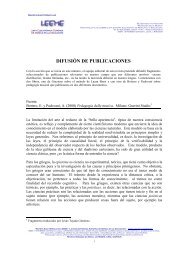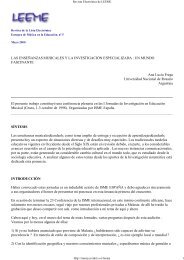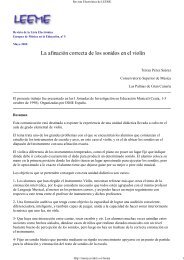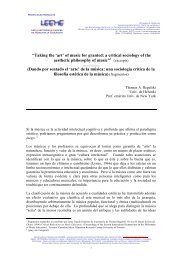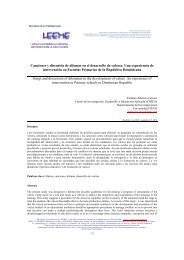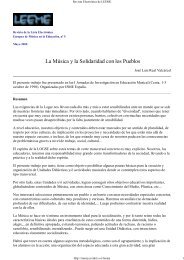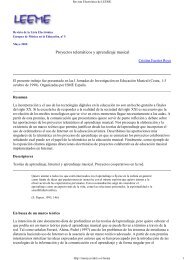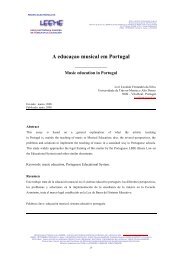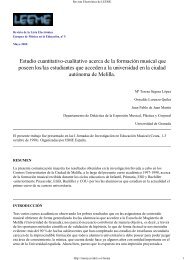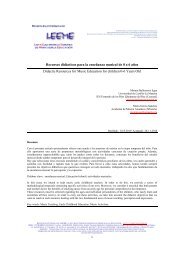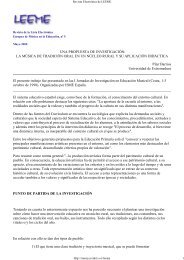La actitud del alumnado de Educación Secundaria hacia la Música ...
La actitud del alumnado de Educación Secundaria hacia la Música ...
La actitud del alumnado de Educación Secundaria hacia la Música ...
You also want an ePaper? Increase the reach of your titles
YUMPU automatically turns print PDFs into web optimized ePapers that Google loves.
© Victoria Eugenia Bautista García<strong>La</strong> <strong>actitud</strong> <strong><strong>de</strong>l</strong> <strong>alumnado</strong> <strong>de</strong> <strong>Educación</strong> <strong>Secundaria</strong> <strong>hacia</strong> <strong>la</strong> <strong>Música</strong> Clásicaen Andalucía <strong>de</strong>s<strong>de</strong> su estudio analítico-<strong>de</strong>scriptivoRevista Electrónica <strong>de</strong> LEEME (Lista Europea Electrónica <strong>de</strong> <strong>Música</strong> en <strong>la</strong> <strong>Educación</strong>)Number 31 (June, 2013), pp. 1-32http://musica.rediris.es/leeme<strong>La</strong> <strong>actitud</strong> <strong><strong>de</strong>l</strong> <strong>alumnado</strong> <strong>de</strong> <strong>Educación</strong> <strong>Secundaria</strong> <strong>hacia</strong> <strong>la</strong> <strong>Música</strong> Clásicaen Andalucía. Un estudio analítico-<strong>de</strong>scriptivoAndalusian Middle School Stu<strong>de</strong>nts´ Attitu<strong>de</strong> toward C<strong>la</strong>ssical Music: a Descriptive-Analytic ResearchVictoria Eugenia Bautista GarcíaDep. Didáctica <strong>de</strong> <strong>la</strong> Expresión Musical, Plástica y CorporalUniversidad <strong>de</strong> Má<strong>la</strong>gavicbaugar@uma.esRecibido: 13-01-13 Aceptado: 12-05-13ResumenEn <strong>la</strong> última década, con <strong>la</strong> introducción <strong>de</strong> numerosas ten<strong>de</strong>ncias musicales, <strong>la</strong> música clásica ha quedado obsoletatanto <strong>de</strong>ntro como fuera <strong>de</strong> nuestras au<strong>la</strong>s. Este fenómeno se observa en el grado <strong>de</strong> <strong>actitud</strong> que muestra el <strong>alumnado</strong><strong>de</strong> <strong>Secundaria</strong> a <strong>la</strong> hora <strong>de</strong> interiorizar algún concepto re<strong>la</strong>cionado con <strong>la</strong> música clásica y así se refleja a<strong>de</strong>más enotras investigaciones. Esta investigación estudia <strong>la</strong> <strong>actitud</strong> <strong>hacia</strong> <strong>la</strong> música clásica existente en Andalucía. Partiendo<strong>de</strong> esta premisa, se construye un cuestionario para analizar <strong>la</strong> <strong>actitud</strong> <strong><strong>de</strong>l</strong> sujeto <strong>de</strong>s<strong>de</strong> un prisma tridimensional yposteriormente se corre<strong>la</strong>ciona con alguno <strong>de</strong> los elementos formadores <strong>de</strong> <strong>la</strong> <strong>actitud</strong> general <strong><strong>de</strong>l</strong> sujeto (familia,grupo <strong>de</strong> iguales, etc) a fin <strong>de</strong> averiguar algunos <strong>de</strong> los factores <strong>de</strong>terminantes <strong><strong>de</strong>l</strong> cambio <strong>de</strong> <strong>actitud</strong> <strong><strong>de</strong>l</strong> <strong>alumnado</strong> <strong>de</strong><strong>Secundaria</strong> frente a <strong>la</strong> música clásica en Andalucía.Pa<strong>la</strong>bras c<strong>la</strong>ve: <strong>actitud</strong>, <strong>alumnado</strong>, <strong>Educación</strong> <strong>Secundaria</strong> Obligatoria, música clásica.AbstractIn the <strong>la</strong>st ten years, with the introduction of various musical trends, the teaching of C<strong>la</strong>ssical Music has becomeobsolete insi<strong>de</strong> as well as outsi<strong>de</strong> of the c<strong>la</strong>ssroom. This phenomenon, also noted in other research, has been observedin the attitu<strong>de</strong>s stu<strong>de</strong>nts <strong>de</strong>monstrate when asked re<strong>la</strong>te their own concept of C<strong>la</strong>ssical music. This article studiesexisting attitu<strong>de</strong>s towards C<strong>la</strong>ssical music in Andalusia. Based on this premise, we <strong>de</strong>signed a questionnaire toanalyze these attitu<strong>de</strong>s from a three-dimensional approach. Subsequently these attitu<strong>de</strong>s were re<strong>la</strong>ted to otherelements (family, peer group, etc.) trying to discover the <strong>de</strong>termining factors that account for the change in stu<strong>de</strong>ntattitu<strong>de</strong>s to C<strong>la</strong>ssical Music in Andalusia.Keywords: attitu<strong>de</strong>, stu<strong>de</strong>nts, education, high school, C<strong>la</strong>ssical Music.REVISTA ELECTRÓNICA DE LEEME –LISTA ELECTRÓNICA EUROPEA DE MÚSICA EN LA EDUCACIÓN-.HTTP://MUSICA.REDIRIS.ES.ISSN: 1575-9563DEPÓSITO. LEGAL: LR-9-2000. DIRECCIÓN: JESÚS TEJADA GIMÉNEZ, CARMEN ANGULO SÁNCHEZ-PRIETO. CONSEJO EDITORIAL: J.L. ARÓSTEGUI, C.CALMELL, M. KATZ, A. LAUCIRICA, O. LORENZO, M. PIATTI, M. VILAR. EDITORES: UNIVERSIDAD DE LA RIOJA Y JESÚS TEJADA GIMÉNEZ. VISIBILIDAD DE ESTAREVISTA: CINDOC (CESIC), DIALNET, DICE (CSIC), DOAJ, E-REVISTAS (CSIC), INTUTE ARTS&HUMANITIES, IN-RECS, LATINDEX, RESH, RILM,ZEITSCHRIFTDATENBANK, ESTA REVISTA ESTÁ PUBLICADA CON EL APOYO INSTITUCIONAL DE REDIRIS-CONSEJO SUPERIOR DE INVESTIGACIONESCIENTÍFICAS Y ES DE ACCESO LIBRE.1
© Victoria Eugenia Bautista García<strong>La</strong> <strong>actitud</strong> <strong><strong>de</strong>l</strong> <strong>alumnado</strong> <strong>de</strong> <strong>Educación</strong> <strong>Secundaria</strong> <strong>hacia</strong> <strong>la</strong> <strong>Música</strong> Clásicaen Andalucía <strong>de</strong>s<strong>de</strong> su estudio analítico-<strong>de</strong>scriptivoRevista Electrónica <strong>de</strong> LEEME (Lista Europea Electrónica <strong>de</strong> <strong>Música</strong> en <strong>la</strong> <strong>Educación</strong>)Number 31 (June, 2013), pp. 1-32http://musica.rediris.es/leeme1. IntroducciónEsta investigación nace <strong>de</strong> <strong>la</strong> observación personal <strong>de</strong> una <strong>actitud</strong> negativa <strong>hacia</strong><strong>la</strong> música clásica proce<strong>de</strong>nte <strong><strong>de</strong>l</strong> <strong>alumnado</strong> <strong>de</strong> <strong>Educación</strong> <strong>Secundaria</strong> Obligatoria endiversos Institutos <strong>de</strong> Andalucía. A partir <strong>de</strong> aquí, se p<strong>la</strong>ntean diversas cuestiones, entreel<strong>la</strong>s, si realmente este colectivo tiene una predisposición negativa <strong>hacia</strong> este tipo <strong>de</strong>música o si su falta <strong>de</strong> motivación se <strong>de</strong>be a <strong>la</strong> escasez <strong>de</strong> activida<strong>de</strong>s realizadas en elcentro educativo, a <strong>la</strong> educación <strong>de</strong> los padres y familiares, a <strong>la</strong> influencia <strong><strong>de</strong>l</strong> grupo <strong>de</strong>iguales, etc.Algunos estudios sobre <strong>la</strong> <strong>actitud</strong> frente a <strong>la</strong> música clásica muestran que <strong>la</strong>utilización <strong>de</strong> este tipo <strong>de</strong> música en el au<strong>la</strong> mejora el comportamiento <strong>de</strong> los individuos(An<strong>de</strong>rs, 2011); otros aducen que algunos elementos re<strong>la</strong>cionados con <strong>la</strong> subcultura <strong><strong>de</strong>l</strong>sujeto, <strong>la</strong> edad o el género son factores <strong>de</strong>terminantes en su cambio <strong>de</strong> <strong>actitud</strong> (Chun-Fu, y Hu, 2006); o que <strong>la</strong>s habilida<strong>de</strong>s auditivas adquiridas por los adolescentes para <strong>la</strong>música pop pue<strong>de</strong>n ser trasvasables a <strong>la</strong> música clásica (McPhail, 2013; Teitsma, 2010).Junto a estos estudios, l<strong>la</strong>ma <strong>la</strong> atención que el número <strong>de</strong> investigaciones sobre el gustomusical <strong><strong>de</strong>l</strong> individuo frente a <strong>la</strong> música clásica aumente en mayor proporción que <strong>la</strong>sre<strong>la</strong>cionadas con <strong>la</strong> <strong>actitud</strong> musical, siendo un elemento inmerso en dicho constructo. <strong>La</strong>causa <strong>de</strong> ello pue<strong>de</strong> <strong>de</strong>berse a <strong>la</strong> variedad <strong>de</strong> respuestas que ofrece el componenteconductual en corre<strong>la</strong>ción con <strong>la</strong> <strong>actitud</strong> <strong><strong>de</strong>l</strong> individuo (Chybowsky, 2008).Concretamente con este estudio intentamos <strong>de</strong>scribir <strong>la</strong> naturaleza <strong>de</strong> esta <strong>actitud</strong>negativa y tratar <strong>de</strong> averiguar si el aumento <strong>de</strong> <strong>la</strong> muestra pob<strong>la</strong>cional pue<strong>de</strong> llegar a<strong>de</strong>terminar una <strong>actitud</strong> diferente <strong>de</strong> <strong>la</strong> observada. Por ello vamos más allá <strong>de</strong> los gustosmusicales <strong>de</strong> los adolescentes, centrándonos en una búsqueda exhaustiva <strong>de</strong> losREVISTA ELECTRÓNICA DE LEEME –LISTA ELECTRÓNICA EUROPEA DE MÚSICA EN LA EDUCACIÓN-.HTTP://MUSICA.REDIRIS.ES.ISSN: 1575-9563DEPÓSITO. LEGAL: LR-9-2000. DIRECCIÓN: JESÚS TEJADA GIMÉNEZ, CARMEN ANGULO SÁNCHEZ-PRIETO. CONSEJO EDITORIAL: J.L. ARÓSTEGUI, C.CALMELL, M. KATZ, A. LAUCIRICA, O. LORENZO, M. PIATTI, M. VILAR. EDITORES: UNIVERSIDAD DE LA RIOJA Y JESÚS TEJADA GIMÉNEZ. VISIBILIDAD DE ESTAREVISTA: CINDOC (CESIC), DIALNET, DICE (CSIC), DOAJ, E-REVISTAS (CSIC), INTUTE ARTS&HUMANITIES, IN-RECS, LATINDEX, RESH, RILM,ZEITSCHRIFTDATENBANK, ESTA REVISTA ESTÁ PUBLICADA CON EL APOYO INSTITUCIONAL DE REDIRIS-CONSEJO SUPERIOR DE INVESTIGACIONESCIENTÍFICAS Y ES DE ACCESO LIBRE.2
© Victoria Eugenia Bautista García<strong>La</strong> <strong>actitud</strong> <strong><strong>de</strong>l</strong> <strong>alumnado</strong> <strong>de</strong> <strong>Educación</strong> <strong>Secundaria</strong> <strong>hacia</strong> <strong>la</strong> <strong>Música</strong> Clásicaen Andalucía <strong>de</strong>s<strong>de</strong> su estudio analítico-<strong>de</strong>scriptivoRevista Electrónica <strong>de</strong> LEEME (Lista Europea Electrónica <strong>de</strong> <strong>Música</strong> en <strong>la</strong> <strong>Educación</strong>)Number 31 (June, 2013), pp. 1-32http://musica.rediris.es/leemeconstructos que <strong>de</strong>finen <strong>la</strong> <strong>actitud</strong> musical <strong>de</strong> este colectivo con el objeto <strong>de</strong> conocer sushábitos, gustos y emociones <strong>hacia</strong> <strong>la</strong> música clásica en el au<strong>la</strong>.2. Revisión teóricaDes<strong>de</strong> los estudios <strong>de</strong> Allport en 1935, numerosos investigadores <strong><strong>de</strong>l</strong> campo <strong><strong>de</strong>l</strong>a Psicología <strong>de</strong> <strong>la</strong> <strong>Educación</strong> estudian el concepto <strong>actitud</strong>inal <strong>de</strong>s<strong>de</strong> prismas diferentes(Santrock, 2003; Megías y Rodríguez, 2004; Rudman, 2004). Actualmente se tien<strong>de</strong><strong>hacia</strong> un nuevo enfoque implícito-explícito (Rudman, 2004), aunque no por ello quedaobsoleto el concepto clásico tridimensional (Allport, 1935; Zanna y Rempel, 1988) y<strong><strong>de</strong>l</strong> que toma su base este estudio.De nuestra investigación <strong>de</strong>ducimos que algunos factores, como el entornofamiliar o el grupo <strong>de</strong> iguales, son <strong>de</strong>terminantes en <strong>la</strong> <strong>actitud</strong> <strong><strong>de</strong>l</strong> estudiante <strong>de</strong> E.S.O.<strong>hacia</strong> <strong>la</strong> música clásica. En el estudio <strong>de</strong> Bogt, D. y van Zalk (2011) se comprueba <strong>la</strong>gran repercusión que tiene el factor familiar en <strong>la</strong>s preferencias musicales <strong><strong>de</strong>l</strong>adolescente, cuyo gusto por <strong>la</strong> música pop y rock se transmite <strong>de</strong> padres a hijos. Estaapreciación <strong>hacia</strong> <strong>de</strong>terminado tipo <strong>de</strong> música conlleva un hábito <strong>de</strong> escucha inculcadopor los padres <strong>de</strong> generación en generación.Si nos paramos a pensar en <strong>la</strong> consecuencia conductual que pue<strong>de</strong> tener el hábito<strong>de</strong> escucha sobre distintas c<strong>la</strong>ses <strong>de</strong> estilos musicales, po<strong>de</strong>mos seña<strong>la</strong>r el estudio <strong>de</strong>Mul<strong>de</strong>r, Bogt, Raaijmakers y Vollebergh (2007), en el que se analiza <strong>la</strong> diferenciaconductual existente entre el <strong>alumnado</strong> <strong>de</strong> secundaria que escucha un tipo <strong>de</strong> música uotro. Es interesante conocer los resultados <strong>de</strong> este estudio <strong>de</strong> cuya muestra 1 se infiereque <strong>la</strong> mayoría <strong>de</strong> adolescentes que escuchan música Pop, Rock y Urbana, exteriorizansus problemas frente a otra minoría cuyas preferencias son el Middle on the road,1 4.159 adolescentes <strong>de</strong> eda<strong>de</strong>s comprendidas entre los 12 y 18 años.REVISTA ELECTRÓNICA DE LEEME –LISTA ELECTRÓNICA EUROPEA DE MÚSICA EN LA EDUCACIÓN-.HTTP://MUSICA.REDIRIS.ES.ISSN: 1575-9563DEPÓSITO. LEGAL: LR-9-2000. DIRECCIÓN: JESÚS TEJADA GIMÉNEZ, CARMEN ANGULO SÁNCHEZ-PRIETO. CONSEJO EDITORIAL: J.L. ARÓSTEGUI, C.CALMELL, M. KATZ, A. LAUCIRICA, O. LORENZO, M. PIATTI, M. VILAR. EDITORES: UNIVERSIDAD DE LA RIOJA Y JESÚS TEJADA GIMÉNEZ. VISIBILIDAD DE ESTAREVISTA: CINDOC (CESIC), DIALNET, DICE (CSIC), DOAJ, E-REVISTAS (CSIC), INTUTE ARTS&HUMANITIES, IN-RECS, LATINDEX, RESH, RILM,ZEITSCHRIFTDATENBANK, ESTA REVISTA ESTÁ PUBLICADA CON EL APOYO INSTITUCIONAL DE REDIRIS-CONSEJO SUPERIOR DE INVESTIGACIONESCIENTÍFICAS Y ES DE ACCESO LIBRE.3
© Victoria Eugenia Bautista García<strong>La</strong> <strong>actitud</strong> <strong><strong>de</strong>l</strong> <strong>alumnado</strong> <strong>de</strong> <strong>Educación</strong> <strong>Secundaria</strong> <strong>hacia</strong> <strong>la</strong> <strong>Música</strong> Clásicaen Andalucía <strong>de</strong>s<strong>de</strong> su estudio analítico-<strong>de</strong>scriptivoRevista Electrónica <strong>de</strong> LEEME (Lista Europea Electrónica <strong>de</strong> <strong>Música</strong> en <strong>la</strong> <strong>Educación</strong>)Number 31 (June, 2013), pp. 1-32http://musica.rediris.es/leemel<strong>la</strong>mados Elitist and Omnivores 2 , que los interiorizan. En este estudio se comprueba quelos hábitos <strong>de</strong> escucha, re<strong>la</strong>cionados con <strong>de</strong>terminado tipo <strong>de</strong> música, <strong>de</strong>terminan <strong>la</strong>conducta <strong><strong>de</strong>l</strong> <strong>alumnado</strong> <strong>de</strong> secundaria ho<strong>la</strong>ndés.Respecto al grupo <strong>de</strong> iguales, el estudio <strong>de</strong> Megías y Rodríguez (2003) estableceesta variable como otro <strong>de</strong> los elementos fundamentales que conforma <strong>la</strong> <strong>actitud</strong>musical y el gusto <strong><strong>de</strong>l</strong> adolescente español y cuyos resultados contrastaremos a lo <strong>la</strong>rgo<strong>de</strong> este trabajo.Otro <strong>de</strong> los factores a tener en cuenta es <strong>la</strong> repercusión que pue<strong>de</strong> tener el lugar<strong>de</strong> resi<strong>de</strong>ncia sobre <strong>la</strong> <strong>actitud</strong> musical <strong><strong>de</strong>l</strong> sujeto. En <strong>la</strong> revisión <strong>de</strong> <strong>la</strong> literaturaencontramos un estudio <strong>de</strong> Cheyne y Bin<strong>de</strong>r (2010) que establece que el lugar <strong>de</strong>resi<strong>de</strong>ncia <strong>de</strong> los adolescentes <strong>de</strong>termina sus gustos musicales a<strong>de</strong>más <strong>de</strong> suspreferencias sociales. Quizá el sentido <strong>de</strong> estos resultados venga <strong>de</strong>terminado por <strong>la</strong>lógica intra-género <strong>de</strong> <strong>la</strong> apropiación que se encuentra en <strong>la</strong> muestra, con unaconsecuente incorporación o un rechazo <strong>de</strong> los objetos culturales re<strong>la</strong>cionados con lossignificados asociados a su “contexto <strong>de</strong> producción” o lugar <strong>de</strong> resi<strong>de</strong>ncia. En estalínea, un estudio español que investiga <strong>la</strong>s preferencias musicales <strong><strong>de</strong>l</strong> <strong>alumnado</strong> <strong>de</strong>E.S.O. en <strong>la</strong> ciudad autónoma <strong>de</strong> Melil<strong>la</strong> concreta que el lugar <strong>de</strong> resi<strong>de</strong>ncia <strong>de</strong> estesujeto influye sobre su gusto musical. Se verifica que el <strong>alumnado</strong> bereber tien<strong>de</strong> <strong>hacia</strong>una música étnica, mientras el europeo prefiere <strong>la</strong> música pop re<strong>la</strong>cionada con su lugar<strong>de</strong> proce<strong>de</strong>ncia (Lorenzo, Herrera y Crema<strong>de</strong>s, 2008). En ambos estudios, los resultadosextraídos difieren <strong>de</strong> los obtenidos en nuestra investigación, cuyas conclusionessugieren una <strong>actitud</strong> musical simi<strong>la</strong>r en sujetos proce<strong>de</strong>ntes tanto <strong>de</strong> núcleos urbanoscomo rurales.2 Los grupos musicales omnivoros se caracterizan porque sus gustos estéticos han superado el esquema monolegitimista basado en <strong>la</strong> distinciónjerárquica entre alta cultura y cultura popu<strong>la</strong>r volviéndose cada vez más variados y tolerantes (Ariño, 2007).REVISTA ELECTRÓNICA DE LEEME –LISTA ELECTRÓNICA EUROPEA DE MÚSICA EN LA EDUCACIÓN-.HTTP://MUSICA.REDIRIS.ES.ISSN: 1575-9563DEPÓSITO. LEGAL: LR-9-2000. DIRECCIÓN: JESÚS TEJADA GIMÉNEZ, CARMEN ANGULO SÁNCHEZ-PRIETO. CONSEJO EDITORIAL: J.L. ARÓSTEGUI, C.CALMELL, M. KATZ, A. LAUCIRICA, O. LORENZO, M. PIATTI, M. VILAR. EDITORES: UNIVERSIDAD DE LA RIOJA Y JESÚS TEJADA GIMÉNEZ. VISIBILIDAD DE ESTAREVISTA: CINDOC (CESIC), DIALNET, DICE (CSIC), DOAJ, E-REVISTAS (CSIC), INTUTE ARTS&HUMANITIES, IN-RECS, LATINDEX, RESH, RILM,ZEITSCHRIFTDATENBANK, ESTA REVISTA ESTÁ PUBLICADA CON EL APOYO INSTITUCIONAL DE REDIRIS-CONSEJO SUPERIOR DE INVESTIGACIONESCIENTÍFICAS Y ES DE ACCESO LIBRE.4
© Victoria Eugenia Bautista García<strong>La</strong> <strong>actitud</strong> <strong><strong>de</strong>l</strong> <strong>alumnado</strong> <strong>de</strong> <strong>Educación</strong> <strong>Secundaria</strong> <strong>hacia</strong> <strong>la</strong> <strong>Música</strong> Clásicaen Andalucía <strong>de</strong>s<strong>de</strong> su estudio analítico-<strong>de</strong>scriptivoRevista Electrónica <strong>de</strong> LEEME (Lista Europea Electrónica <strong>de</strong> <strong>Música</strong> en <strong>la</strong> <strong>Educación</strong>)Number 31 (June, 2013), pp. 1-32http://musica.rediris.es/leeme3. MetodologíaPara este estudio elegimos un estudio post-hoc basado en cuestionario y cuyahipótesis <strong>de</strong> covarianza se basa en el diseño <strong>de</strong> encuesta. <strong>La</strong>s hipótesis <strong>de</strong> covariaciónexplican <strong>la</strong>s re<strong>la</strong>ciones resultantes entre dos o más variables expresadas en términos <strong>de</strong>grados <strong>de</strong> asociación o magnitud <strong>de</strong> <strong>de</strong>pen<strong>de</strong>ncia. Partiendo <strong>de</strong> estos datos, nuestrométodo continúa con <strong>la</strong> siguiente estructura:1. Cálculo y caracterización <strong>de</strong> <strong>la</strong> muestra a<strong>de</strong>cuada para llevar a cabo nuestroestudio.2. Revisión <strong>de</strong> los elementos que conforman nuestro instrumento <strong>de</strong> recolección <strong>de</strong>datos (cuestionario <strong><strong>de</strong>l</strong> <strong>alumnado</strong> <strong>de</strong> E.S.O.).3. Análisis <strong>de</strong> los datos referidos a <strong>la</strong> <strong>actitud</strong> <strong><strong>de</strong>l</strong> <strong>alumnado</strong> <strong>de</strong> E.S.O. y sucorre<strong>la</strong>ción con <strong>la</strong>s distintas variables que componen nuestro constructo.4. Triangu<strong>la</strong>ción <strong><strong>de</strong>l</strong> instrumento (cuestionario <strong><strong>de</strong>l</strong> profesorado).5. Análisis <strong>de</strong> resultados.3.1. Pob<strong>la</strong>ción y muestraCon el fin <strong>de</strong> po<strong>de</strong>r llevar a cabo un correcto análisis sobre <strong>la</strong> <strong>actitud</strong> <strong><strong>de</strong>l</strong>estudiante <strong>de</strong> E.S.O. <strong>hacia</strong> <strong>la</strong> música clásica en <strong>la</strong> comunidad autónoma <strong>de</strong> Andalucía,comenzamos por el cálculo <strong><strong>de</strong>l</strong> tamaño muestral y proseguimos <strong>hacia</strong> sucaracterización.a) Cálculo <strong><strong>de</strong>l</strong> tamaño muestral<strong>La</strong> pob<strong>la</strong>ción sobre <strong>la</strong> que gira nuestra investigación se compone <strong>de</strong> un número<strong>de</strong> 3133 sujetos <strong>de</strong> primer, segundo y cuarto curso <strong>de</strong> E.S.O. proce<strong>de</strong>ntes <strong>de</strong> 40Institutos andaluces.REVISTA ELECTRÓNICA DE LEEME –LISTA ELECTRÓNICA EUROPEA DE MÚSICA EN LA EDUCACIÓN-.HTTP://MUSICA.REDIRIS.ES.ISSN: 1575-9563DEPÓSITO. LEGAL: LR-9-2000. DIRECCIÓN: JESÚS TEJADA GIMÉNEZ, CARMEN ANGULO SÁNCHEZ-PRIETO. CONSEJO EDITORIAL: J.L. ARÓSTEGUI, C.CALMELL, M. KATZ, A. LAUCIRICA, O. LORENZO, M. PIATTI, M. VILAR. EDITORES: UNIVERSIDAD DE LA RIOJA Y JESÚS TEJADA GIMÉNEZ. VISIBILIDAD DE ESTAREVISTA: CINDOC (CESIC), DIALNET, DICE (CSIC), DOAJ, E-REVISTAS (CSIC), INTUTE ARTS&HUMANITIES, IN-RECS, LATINDEX, RESH, RILM,ZEITSCHRIFTDATENBANK, ESTA REVISTA ESTÁ PUBLICADA CON EL APOYO INSTITUCIONAL DE REDIRIS-CONSEJO SUPERIOR DE INVESTIGACIONESCIENTÍFICAS Y ES DE ACCESO LIBRE.5
© Victoria Eugenia Bautista García<strong>La</strong> <strong>actitud</strong> <strong><strong>de</strong>l</strong> <strong>alumnado</strong> <strong>de</strong> <strong>Educación</strong> <strong>Secundaria</strong> <strong>hacia</strong> <strong>la</strong> <strong>Música</strong> Clásicaen Andalucía <strong>de</strong>s<strong>de</strong> su estudio analítico-<strong>de</strong>scriptivoRevista Electrónica <strong>de</strong> LEEME (Lista Europea Electrónica <strong>de</strong> <strong>Música</strong> en <strong>la</strong> <strong>Educación</strong>)Number 31 (June, 2013), pp. 1-32http://musica.rediris.es/leeme<strong>La</strong> muestra se obtiene a través <strong>de</strong> un procedimiento <strong>de</strong> muestreo aleatorio simplepor conglomerados 3 <strong>de</strong> pob<strong>la</strong>ción finita. Con <strong>la</strong> pretensión <strong>de</strong> obtener resultadosextensibles a toda Andalucía y con una fiabilidad elegida <strong><strong>de</strong>l</strong> 95%, partimos <strong>de</strong> lossiguientes datos:1. El tamaño <strong>de</strong> <strong>la</strong> pob<strong>la</strong>ción η=895 caracterizado por el número <strong>de</strong> centros <strong>de</strong><strong>Educación</strong> <strong>Secundaria</strong> Obligatoria <strong>de</strong>pendientes <strong>de</strong> <strong>la</strong> Junta <strong>de</strong> Andalucía.2. <strong>La</strong> varianza pob<strong>la</strong>cional σ = 0,434 <strong>de</strong> nuestra primera muestra.3. Una probabilidad <strong>de</strong> error muestral <strong><strong>de</strong>l</strong> 5%.A partir <strong>de</strong> aquí, <strong>la</strong>s variables computadas fueron <strong>la</strong>s siguientes (tab<strong>la</strong> 1):Tab<strong>la</strong> 1. Variables computadas para <strong>la</strong> extracción <strong>de</strong> <strong>la</strong> muestraA continuación se presenta <strong>la</strong> fórmu<strong>la</strong> <strong>de</strong> don<strong>de</strong> se extrae el número <strong>de</strong> centrosque conforman nuestra muestra (fig. 1):3 El estudio está compuesto por centros <strong>de</strong> <strong>Educación</strong> <strong>Secundaria</strong> <strong>de</strong> <strong>la</strong> Comunidad Autónoma <strong>de</strong> Andalucía. De nuestra categorización excluimos losI.P.E.P., E.A. y S.E.S.A.REVISTA ELECTRÓNICA DE LEEME –LISTA ELECTRÓNICA EUROPEA DE MÚSICA EN LA EDUCACIÓN-.HTTP://MUSICA.REDIRIS.ES.ISSN: 1575-9563DEPÓSITO. LEGAL: LR-9-2000. DIRECCIÓN: JESÚS TEJADA GIMÉNEZ, CARMEN ANGULO SÁNCHEZ-PRIETO. CONSEJO EDITORIAL: J.L. ARÓSTEGUI, C.CALMELL, M. KATZ, A. LAUCIRICA, O. LORENZO, M. PIATTI, M. VILAR. EDITORES: UNIVERSIDAD DE LA RIOJA Y JESÚS TEJADA GIMÉNEZ. VISIBILIDAD DE ESTAREVISTA: CINDOC (CESIC), DIALNET, DICE (CSIC), DOAJ, E-REVISTAS (CSIC), INTUTE ARTS&HUMANITIES, IN-RECS, LATINDEX, RESH, RILM,ZEITSCHRIFTDATENBANK, ESTA REVISTA ESTÁ PUBLICADA CON EL APOYO INSTITUCIONAL DE REDIRIS-CONSEJO SUPERIOR DE INVESTIGACIONESCIENTÍFICAS Y ES DE ACCESO LIBRE.6
© Victoria Eugenia Bautista García<strong>La</strong> <strong>actitud</strong> <strong><strong>de</strong>l</strong> <strong>alumnado</strong> <strong>de</strong> <strong>Educación</strong> <strong>Secundaria</strong> <strong>hacia</strong> <strong>la</strong> <strong>Música</strong> Clásicaen Andalucía <strong>de</strong>s<strong>de</strong> su estudio analítico-<strong>de</strong>scriptivoRevista Electrónica <strong>de</strong> LEEME (Lista Europea Electrónica <strong>de</strong> <strong>Música</strong> en <strong>la</strong> <strong>Educación</strong>)Number 31 (June, 2013), pp. 1-32http://musica.rediris.es/leemeFig. 3. Género <strong>de</strong> los encuestados3.2 InstrumentoTras un extenso recorrido por numerosos estudios actuales sobre <strong>la</strong> <strong>actitud</strong>(An<strong>de</strong>rs, 2011; Chun-Fu y Hu, 2006; Teistma, 2010), comprobamos que no existe uninstrumento capaz <strong>de</strong> <strong>de</strong>finir nuestro constructo. Por ello y con el objeto <strong>de</strong> obtener <strong>la</strong>ssuficientes garantías científicas respecto a su fiabilidad, <strong>de</strong>cidimos construir nuestropropio instrumento <strong>de</strong> recolección <strong>de</strong> datos. Para su e<strong>la</strong>boración, se utilizaron losprocedimientos <strong>de</strong> otro trabajo (Bautista y Mateos, 2011):1. Los componentes <strong>actitud</strong>inales (afectivo, cognitivo y conductual).2. <strong>La</strong> intención <strong><strong>de</strong>l</strong> investigador.3. <strong>La</strong> pob<strong>la</strong>ción (<strong>alumnado</strong> <strong>de</strong> E.S.O. <strong>de</strong> Andalucía).4. <strong>La</strong>s variables <strong><strong>de</strong>l</strong> cambio <strong>de</strong> <strong>actitud</strong> frente a <strong>la</strong> música clásica.5. El diseño visual.Para una mejor concreción <strong><strong>de</strong>l</strong> diseño <strong><strong>de</strong>l</strong> instrumento y para <strong>la</strong> prevención <strong>de</strong>posibles sesgos (aquiescencia, <strong>de</strong>seabilidad social o contaminación), se utilizó elmétodo <strong>de</strong> observación directa, llevado a cabo por los investigadores en el estudiopiloto.REVISTA ELECTRÓNICA DE LEEME –LISTA ELECTRÓNICA EUROPEA DE MÚSICA EN LA EDUCACIÓN-.HTTP://MUSICA.REDIRIS.ES.ISSN: 1575-9563DEPÓSITO. LEGAL: LR-9-2000. DIRECCIÓN: JESÚS TEJADA GIMÉNEZ, CARMEN ANGULO SÁNCHEZ-PRIETO. CONSEJO EDITORIAL: J.L. ARÓSTEGUI, C.CALMELL, M. KATZ, A. LAUCIRICA, O. LORENZO, M. PIATTI, M. VILAR. EDITORES: UNIVERSIDAD DE LA RIOJA Y JESÚS TEJADA GIMÉNEZ. VISIBILIDAD DE ESTAREVISTA: CINDOC (CESIC), DIALNET, DICE (CSIC), DOAJ, E-REVISTAS (CSIC), INTUTE ARTS&HUMANITIES, IN-RECS, LATINDEX, RESH, RILM,ZEITSCHRIFTDATENBANK, ESTA REVISTA ESTÁ PUBLICADA CON EL APOYO INSTITUCIONAL DE REDIRIS-CONSEJO SUPERIOR DE INVESTIGACIONESCIENTÍFICAS Y ES DE ACCESO LIBRE.8
© Victoria Eugenia Bautista García<strong>La</strong> <strong>actitud</strong> <strong><strong>de</strong>l</strong> <strong>alumnado</strong> <strong>de</strong> <strong>Educación</strong> <strong>Secundaria</strong> <strong>hacia</strong> <strong>la</strong> <strong>Música</strong> Clásicaen Andalucía <strong>de</strong>s<strong>de</strong> su estudio analítico-<strong>de</strong>scriptivoRevista Electrónica <strong>de</strong> LEEME (Lista Europea Electrónica <strong>de</strong> <strong>Música</strong> en <strong>la</strong> <strong>Educación</strong>)Number 31 (June, 2013), pp. 1-32http://musica.rediris.es/leeme<strong>La</strong> e<strong>la</strong>boración <strong>de</strong> los ítems se construye sobre el Método <strong>de</strong> EvaluacionesSumarias o Esca<strong>la</strong> <strong>de</strong> Likert, cuyas respuestas polinómicas contienen un número <strong>de</strong> 5niveles <strong>de</strong> intensidad (Morales, 2006). Tras el análisis <strong>de</strong> fiabilidad obtenido <strong>de</strong> los 25ítems que constituyen nuestro cuestionario final, se obtiene una fiabilidad <strong>de</strong> Alfa <strong>de</strong>Cronbach=0,902, lo que indica que el cuestionario resultante es un instrumento <strong>de</strong>medición fiable y útil para comenzar con nuestra investigación.<strong>La</strong>s pon<strong>de</strong>raciones para los ítems positivos o negativos se presentan acontinuación (tab<strong>la</strong>s 2, 3 y 4):Tab<strong>la</strong> 2. Pon<strong>de</strong>ración <strong>de</strong> los ítems <strong><strong>de</strong>l</strong> cuestionarioTab<strong>la</strong> 3. Pon<strong>de</strong>ración <strong>de</strong> los ítems <strong><strong>de</strong>l</strong> cuestionarioREVISTA ELECTRÓNICA DE LEEME –LISTA ELECTRÓNICA EUROPEA DE MÚSICA EN LA EDUCACIÓN-.HTTP://MUSICA.REDIRIS.ES.ISSN: 1575-9563DEPÓSITO. LEGAL: LR-9-2000. DIRECCIÓN: JESÚS TEJADA GIMÉNEZ, CARMEN ANGULO SÁNCHEZ-PRIETO. CONSEJO EDITORIAL: J.L. ARÓSTEGUI, C.CALMELL, M. KATZ, A. LAUCIRICA, O. LORENZO, M. PIATTI, M. VILAR. EDITORES: UNIVERSIDAD DE LA RIOJA Y JESÚS TEJADA GIMÉNEZ. VISIBILIDAD DE ESTAREVISTA: CINDOC (CESIC), DIALNET, DICE (CSIC), DOAJ, E-REVISTAS (CSIC), INTUTE ARTS&HUMANITIES, IN-RECS, LATINDEX, RESH, RILM,ZEITSCHRIFTDATENBANK, ESTA REVISTA ESTÁ PUBLICADA CON EL APOYO INSTITUCIONAL DE REDIRIS-CONSEJO SUPERIOR DE INVESTIGACIONESCIENTÍFICAS Y ES DE ACCESO LIBRE.9
© Victoria Eugenia Bautista García<strong>La</strong> <strong>actitud</strong> <strong><strong>de</strong>l</strong> <strong>alumnado</strong> <strong>de</strong> <strong>Educación</strong> <strong>Secundaria</strong> <strong>hacia</strong> <strong>la</strong> <strong>Música</strong> Clásicaen Andalucía <strong>de</strong>s<strong>de</strong> su estudio analítico-<strong>de</strong>scriptivoRevista Electrónica <strong>de</strong> LEEME (Lista Europea Electrónica <strong>de</strong> <strong>Música</strong> en <strong>la</strong> <strong>Educación</strong>)Number 31 (June, 2013), pp. 1-32http://musica.rediris.es/leemeTab<strong>la</strong> 4. Pon<strong>de</strong>ración <strong>de</strong> los ítems <strong><strong>de</strong>l</strong> cuestionarioA partir <strong>de</strong> aquí y en base al promedio <strong>de</strong> puntuaciones recibidas por cada uno<strong>de</strong> los individuos, se <strong>de</strong>terminan <strong>la</strong>s puntuaciones medias por indicador y porcomponente <strong>actitud</strong>inal interpretadas según <strong>la</strong> siguiente tab<strong>la</strong>, permitiendo <strong>de</strong>terminar <strong>la</strong>intensidad <strong><strong>de</strong>l</strong> cambio <strong>de</strong> <strong>actitud</strong> resultante (tab<strong>la</strong> 5):Tab<strong>la</strong> 5. Baremo <strong>de</strong> intensidad <strong>de</strong> <strong>la</strong> <strong>actitud</strong> por puntuaciones medias obtenida<strong>La</strong>s variables que conforman nuestro cuestionario se exponen a continuación:1. Edad [nivel <strong>de</strong> medida: esca<strong>la</strong>]2. Género [valores: masculino, femenino]3. Realizar cursos extraesco<strong>la</strong>res <strong>de</strong> música [valores: sí, no]4. Componente afectivo [valores: <strong>de</strong> 0 a 5]5. Componente cognitivo [valores: <strong>de</strong> 0 a 5]6. Componente conductual [valores: <strong>de</strong> 0 a 5]7. Variable socio<strong>de</strong>mográfica [valores: rural, urbano]REVISTA ELECTRÓNICA DE LEEME –LISTA ELECTRÓNICA EUROPEA DE MÚSICA EN LA EDUCACIÓN-.HTTP://MUSICA.REDIRIS.ES.ISSN: 1575-9563DEPÓSITO. LEGAL: LR-9-2000. DIRECCIÓN: JESÚS TEJADA GIMÉNEZ, CARMEN ANGULO SÁNCHEZ-PRIETO. CONSEJO EDITORIAL: J.L. ARÓSTEGUI, C.CALMELL, M. KATZ, A. LAUCIRICA, O. LORENZO, M. PIATTI, M. VILAR. EDITORES: UNIVERSIDAD DE LA RIOJA Y JESÚS TEJADA GIMÉNEZ. VISIBILIDAD DE ESTAREVISTA: CINDOC (CESIC), DIALNET, DICE (CSIC), DOAJ, E-REVISTAS (CSIC), INTUTE ARTS&HUMANITIES, IN-RECS, LATINDEX, RESH, RILM,ZEITSCHRIFTDATENBANK, ESTA REVISTA ESTÁ PUBLICADA CON EL APOYO INSTITUCIONAL DE REDIRIS-CONSEJO SUPERIOR DE INVESTIGACIONESCIENTÍFICAS Y ES DE ACCESO LIBRE.10
© Victoria Eugenia Bautista García<strong>La</strong> <strong>actitud</strong> <strong><strong>de</strong>l</strong> <strong>alumnado</strong> <strong>de</strong> <strong>Educación</strong> <strong>Secundaria</strong> <strong>hacia</strong> <strong>la</strong> <strong>Música</strong> Clásicaen Andalucía <strong>de</strong>s<strong>de</strong> su estudio analítico-<strong>de</strong>scriptivoRevista Electrónica <strong>de</strong> LEEME (Lista Europea Electrónica <strong>de</strong> <strong>Música</strong> en <strong>la</strong> <strong>Educación</strong>)Number 31 (June, 2013), pp. 1-32http://musica.rediris.es/leeme4. ResultadosA fin <strong>de</strong> comprobar los factores que inci<strong>de</strong>n directamente sobre <strong>la</strong> <strong>actitud</strong> <strong><strong>de</strong>l</strong><strong>alumnado</strong> andaluz <strong>de</strong> E.S.O., partimos <strong>hacia</strong> el análisis <strong>de</strong> los elementos que repercutendirectamente sobre <strong>la</strong> <strong>actitud</strong> <strong>hacia</strong> <strong>la</strong> música clásica <strong>de</strong> nuestro discente.4.1. Actitud <strong><strong>de</strong>l</strong> <strong>alumnado</strong> <strong>de</strong> E.S.O. frente a <strong>la</strong> música clásica en Andalucía<strong>La</strong> <strong>actitud</strong> global <strong>de</strong>termina los resultados obtenidos por el conjunto <strong>de</strong> loscomponentes <strong>actitud</strong>inales (v.gr. afectivo, cognitivo y conductual). Si observamos elgráfico expuesto a continuación, po<strong>de</strong>mos extraer que <strong>la</strong> curva <strong>de</strong> Gauss presenta unac<strong>la</strong>ra ten<strong>de</strong>ncia <strong>hacia</strong> <strong>la</strong> izquierda, con una mínima curtosis <strong>la</strong>teral <strong>de</strong>recha (0,357) y unamedia que se sitúa en un nivel inferior al nivel óptimo <strong>de</strong> normalidad (2,22). De aquípo<strong>de</strong>mos inferir <strong>la</strong> negatividad que caracteriza a <strong>la</strong> <strong>actitud</strong> <strong><strong>de</strong>l</strong> estudiante andaluz frentea <strong>la</strong> música clásica (fig. 4):Fig. 4. Histograma <strong>de</strong> <strong>la</strong> <strong>actitud</strong> global <strong><strong>de</strong>l</strong> <strong>alumnado</strong> <strong>de</strong> E.S.O.En el siguiente diagrama (fig. 5) se presenta con mayor c<strong>la</strong>ridad el grado <strong>de</strong><strong>actitud</strong> resultante <strong><strong>de</strong>l</strong> análisis <strong>de</strong> sus tres componentes <strong>actitud</strong>inales:REVISTA ELECTRÓNICA DE LEEME –LISTA ELECTRÓNICA EUROPEA DE MÚSICA EN LA EDUCACIÓN-.HTTP://MUSICA.REDIRIS.ES.ISSN: 1575-9563DEPÓSITO. LEGAL: LR-9-2000. DIRECCIÓN: JESÚS TEJADA GIMÉNEZ, CARMEN ANGULO SÁNCHEZ-PRIETO. CONSEJO EDITORIAL: J.L. ARÓSTEGUI, C.CALMELL, M. KATZ, A. LAUCIRICA, O. LORENZO, M. PIATTI, M. VILAR. EDITORES: UNIVERSIDAD DE LA RIOJA Y JESÚS TEJADA GIMÉNEZ. VISIBILIDAD DE ESTAREVISTA: CINDOC (CESIC), DIALNET, DICE (CSIC), DOAJ, E-REVISTAS (CSIC), INTUTE ARTS&HUMANITIES, IN-RECS, LATINDEX, RESH, RILM,ZEITSCHRIFTDATENBANK, ESTA REVISTA ESTÁ PUBLICADA CON EL APOYO INSTITUCIONAL DE REDIRIS-CONSEJO SUPERIOR DE INVESTIGACIONESCIENTÍFICAS Y ES DE ACCESO LIBRE.11
© Victoria Eugenia Bautista García<strong>La</strong> <strong>actitud</strong> <strong><strong>de</strong>l</strong> <strong>alumnado</strong> <strong>de</strong> <strong>Educación</strong> <strong>Secundaria</strong> <strong>hacia</strong> <strong>la</strong> <strong>Música</strong> Clásicaen Andalucía <strong>de</strong>s<strong>de</strong> su estudio analítico-<strong>de</strong>scriptivoRevista Electrónica <strong>de</strong> LEEME (Lista Europea Electrónica <strong>de</strong> <strong>Música</strong> en <strong>la</strong> <strong>Educación</strong>)Number 31 (June, 2013), pp. 1-32http://musica.rediris.es/leemeFig. 5. Actitud global <strong><strong>de</strong>l</strong> <strong>alumnado</strong> <strong>de</strong> E.S.O.Tab<strong>la</strong> 6. Actitud global <strong><strong>de</strong>l</strong> <strong>alumnado</strong> <strong>de</strong> E.S.O. <strong>hacia</strong> <strong>la</strong> música clásica y sus componentes.<strong>La</strong> <strong>actitud</strong> antedicha viene pre<strong>de</strong>terminada por sus tres componentes <strong>actitud</strong>inalescuyo análisis individual se expone a continuación.REVISTA ELECTRÓNICA DE LEEME –LISTA ELECTRÓNICA EUROPEA DE MÚSICA EN LA EDUCACIÓN-.HTTP://MUSICA.REDIRIS.ES.ISSN: 1575-9563DEPÓSITO. LEGAL: LR-9-2000. DIRECCIÓN: JESÚS TEJADA GIMÉNEZ, CARMEN ANGULO SÁNCHEZ-PRIETO. CONSEJO EDITORIAL: J.L. ARÓSTEGUI, C.CALMELL, M. KATZ, A. LAUCIRICA, O. LORENZO, M. PIATTI, M. VILAR. EDITORES: UNIVERSIDAD DE LA RIOJA Y JESÚS TEJADA GIMÉNEZ. VISIBILIDAD DE ESTAREVISTA: CINDOC (CESIC), DIALNET, DICE (CSIC), DOAJ, E-REVISTAS (CSIC), INTUTE ARTS&HUMANITIES, IN-RECS, LATINDEX, RESH, RILM,ZEITSCHRIFTDATENBANK, ESTA REVISTA ESTÁ PUBLICADA CON EL APOYO INSTITUCIONAL DE REDIRIS-CONSEJO SUPERIOR DE INVESTIGACIONESCIENTÍFICAS Y ES DE ACCESO LIBRE.12
© Victoria Eugenia Bautista García<strong>La</strong> <strong>actitud</strong> <strong><strong>de</strong>l</strong> <strong>alumnado</strong> <strong>de</strong> <strong>Educación</strong> <strong>Secundaria</strong> <strong>hacia</strong> <strong>la</strong> <strong>Música</strong> Clásicaen Andalucía <strong>de</strong>s<strong>de</strong> su estudio analítico-<strong>de</strong>scriptivoRevista Electrónica <strong>de</strong> LEEME (Lista Europea Electrónica <strong>de</strong> <strong>Música</strong> en <strong>la</strong> <strong>Educación</strong>)Number 31 (June, 2013), pp. 1-32http://musica.rediris.es/leemeFig. 6. Histograma <strong><strong>de</strong>l</strong> componente afectivoComo se extrae <strong>de</strong> los resultados estadísticos (tab<strong>la</strong> 6), <strong>la</strong> media <strong><strong>de</strong>l</strong> componenteafectivo se sitúa en un nivel superior a <strong>la</strong> media <strong>de</strong> nuestra esca<strong>la</strong> Likert (3,11) con loque se confirma <strong>la</strong> normalidad <strong>de</strong> <strong>la</strong> muestra. <strong>La</strong> moda se sitúa en 3,00 mostrando unaten<strong>de</strong>ncia positiva, mientras <strong>la</strong> asimetría y curtosis muestran una mayor <strong>de</strong>nsidad <strong>de</strong>distribución en <strong>la</strong> zona negativa.En el <strong>la</strong>do opuesto al componente afectivo, se encuentran los componentescognitivo y conductual, <strong>de</strong>terminantes <strong>de</strong> <strong>la</strong> <strong>actitud</strong> negativa <strong><strong>de</strong>l</strong> sujeto, como se muestraa continuación. El siguiente histograma (fig. 7) presenta una curtosis <strong>la</strong>teral izquierda,con una media situada en un nivel inferior al nivel medio <strong>de</strong> normalidad (2,25). Losanálisis estadísticos (tab<strong>la</strong> 6) concretan esta negatividad. Todo ello nos lleva ap<strong>la</strong>ntearnos el hecho <strong>de</strong> que este colectivo pob<strong>la</strong>cional apenas tiene conocimientos sobremúsica clásica.REVISTA ELECTRÓNICA DE LEEME –LISTA ELECTRÓNICA EUROPEA DE MÚSICA EN LA EDUCACIÓN-.HTTP://MUSICA.REDIRIS.ES.ISSN: 1575-9563DEPÓSITO. LEGAL: LR-9-2000. DIRECCIÓN: JESÚS TEJADA GIMÉNEZ, CARMEN ANGULO SÁNCHEZ-PRIETO. CONSEJO EDITORIAL: J.L. ARÓSTEGUI, C.CALMELL, M. KATZ, A. LAUCIRICA, O. LORENZO, M. PIATTI, M. VILAR. EDITORES: UNIVERSIDAD DE LA RIOJA Y JESÚS TEJADA GIMÉNEZ. VISIBILIDAD DE ESTAREVISTA: CINDOC (CESIC), DIALNET, DICE (CSIC), DOAJ, E-REVISTAS (CSIC), INTUTE ARTS&HUMANITIES, IN-RECS, LATINDEX, RESH, RILM,ZEITSCHRIFTDATENBANK, ESTA REVISTA ESTÁ PUBLICADA CON EL APOYO INSTITUCIONAL DE REDIRIS-CONSEJO SUPERIOR DE INVESTIGACIONESCIENTÍFICAS Y ES DE ACCESO LIBRE.13
© Victoria Eugenia Bautista García<strong>La</strong> <strong>actitud</strong> <strong><strong>de</strong>l</strong> <strong>alumnado</strong> <strong>de</strong> <strong>Educación</strong> <strong>Secundaria</strong> <strong>hacia</strong> <strong>la</strong> <strong>Música</strong> Clásicaen Andalucía <strong>de</strong>s<strong>de</strong> su estudio analítico-<strong>de</strong>scriptivoRevista Electrónica <strong>de</strong> LEEME (Lista Europea Electrónica <strong>de</strong> <strong>Música</strong> en <strong>la</strong> <strong>Educación</strong>)Number 31 (June, 2013), pp. 1-32http://musica.rediris.es/leemeFig. 7. Histograma <strong><strong>de</strong>l</strong> componente cognoscitivoEn el caso <strong>de</strong> <strong>la</strong> conducta <strong><strong>de</strong>l</strong> <strong>alumnado</strong> <strong>de</strong> E.S.O., a simple vista se <strong>de</strong>riva <strong>de</strong> <strong>la</strong>siguiente gráfica una ten<strong>de</strong>ncia negativa, con una curtosis <strong>la</strong>teral izquierda significativa(fig. 8).Fig. 8. Histograma <strong><strong>de</strong>l</strong> componente conductualA partir <strong>de</strong> estos resultados po<strong>de</strong>mos aseverar que <strong>la</strong> negatividad <strong>actitud</strong>inalresultante <strong>de</strong> nuestro estudio viene pre<strong>de</strong>terminada por los componentes conductual ycognitivo especialmente negativos.REVISTA ELECTRÓNICA DE LEEME –LISTA ELECTRÓNICA EUROPEA DE MÚSICA EN LA EDUCACIÓN-.HTTP://MUSICA.REDIRIS.ES.ISSN: 1575-9563DEPÓSITO. LEGAL: LR-9-2000. DIRECCIÓN: JESÚS TEJADA GIMÉNEZ, CARMEN ANGULO SÁNCHEZ-PRIETO. CONSEJO EDITORIAL: J.L. ARÓSTEGUI, C.CALMELL, M. KATZ, A. LAUCIRICA, O. LORENZO, M. PIATTI, M. VILAR. EDITORES: UNIVERSIDAD DE LA RIOJA Y JESÚS TEJADA GIMÉNEZ. VISIBILIDAD DE ESTAREVISTA: CINDOC (CESIC), DIALNET, DICE (CSIC), DOAJ, E-REVISTAS (CSIC), INTUTE ARTS&HUMANITIES, IN-RECS, LATINDEX, RESH, RILM,ZEITSCHRIFTDATENBANK, ESTA REVISTA ESTÁ PUBLICADA CON EL APOYO INSTITUCIONAL DE REDIRIS-CONSEJO SUPERIOR DE INVESTIGACIONESCIENTÍFICAS Y ES DE ACCESO LIBRE.14
© Victoria Eugenia Bautista García<strong>La</strong> <strong>actitud</strong> <strong><strong>de</strong>l</strong> <strong>alumnado</strong> <strong>de</strong> <strong>Educación</strong> <strong>Secundaria</strong> <strong>hacia</strong> <strong>la</strong> <strong>Música</strong> Clásicaen Andalucía <strong>de</strong>s<strong>de</strong> su estudio analítico-<strong>de</strong>scriptivoRevista Electrónica <strong>de</strong> LEEME (Lista Europea Electrónica <strong>de</strong> <strong>Música</strong> en <strong>la</strong> <strong>Educación</strong>)Number 31 (June, 2013), pp. 1-32http://musica.rediris.es/leemeTab<strong>la</strong> 7. Análisis <strong>de</strong> frecuencias <strong>de</strong> <strong>la</strong> <strong>actitud</strong> global <strong><strong>de</strong>l</strong> <strong>alumnado</strong> <strong>de</strong> E.S.O. <strong>hacia</strong> <strong>la</strong> música clásica en Andalucía4.2. Factores <strong>de</strong>terminantes que inci<strong>de</strong>n en <strong>la</strong> <strong>actitud</strong> <strong><strong>de</strong>l</strong> <strong>alumnado</strong> <strong>de</strong> E.S.O. <strong>hacia</strong><strong>la</strong> música clásica en AndalucíaPara conocer algunos <strong>de</strong> los elementos que influyen directamente en <strong>la</strong> <strong>actitud</strong> <strong><strong>de</strong>l</strong><strong>alumnado</strong> <strong>de</strong> E.S.O. <strong>hacia</strong> <strong>la</strong> música clásica, proce<strong>de</strong>mos al análisis <strong>de</strong> <strong>la</strong>s distintasvariables que componen nuestro constructo.a) Edad <strong>de</strong> los encuestadosRespecto a <strong>la</strong> edad <strong>de</strong> los sujetos, <strong>de</strong> los resultados estadísticos (gráfico <strong>de</strong>dispersión y frecuencia) inferimos que <strong>la</strong> intensidad <strong><strong>de</strong>l</strong> cambio <strong>de</strong> <strong>actitud</strong> es mínima,con lo que po<strong>de</strong>mos concluir que <strong>la</strong> edad <strong>de</strong> los encuestados no es un elemento<strong>de</strong>terminante <strong>de</strong> su <strong>actitud</strong> <strong>hacia</strong> <strong>la</strong> música clásica (fig. 9 y tab<strong>la</strong> 7):REVISTA ELECTRÓNICA DE LEEME –LISTA ELECTRÓNICA EUROPEA DE MÚSICA EN LA EDUCACIÓN-.HTTP://MUSICA.REDIRIS.ES.ISSN: 1575-9563DEPÓSITO. LEGAL: LR-9-2000. DIRECCIÓN: JESÚS TEJADA GIMÉNEZ, CARMEN ANGULO SÁNCHEZ-PRIETO. CONSEJO EDITORIAL: J.L. ARÓSTEGUI, C.CALMELL, M. KATZ, A. LAUCIRICA, O. LORENZO, M. PIATTI, M. VILAR. EDITORES: UNIVERSIDAD DE LA RIOJA Y JESÚS TEJADA GIMÉNEZ. VISIBILIDAD DE ESTAREVISTA: CINDOC (CESIC), DIALNET, DICE (CSIC), DOAJ, E-REVISTAS (CSIC), INTUTE ARTS&HUMANITIES, IN-RECS, LATINDEX, RESH, RILM,ZEITSCHRIFTDATENBANK, ESTA REVISTA ESTÁ PUBLICADA CON EL APOYO INSTITUCIONAL DE REDIRIS-CONSEJO SUPERIOR DE INVESTIGACIONESCIENTÍFICAS Y ES DE ACCESO LIBRE.15
© Victoria Eugenia Bautista García<strong>La</strong> <strong>actitud</strong> <strong><strong>de</strong>l</strong> <strong>alumnado</strong> <strong>de</strong> <strong>Educación</strong> <strong>Secundaria</strong> <strong>hacia</strong> <strong>la</strong> <strong>Música</strong> Clásicaen Andalucía <strong>de</strong>s<strong>de</strong> su estudio analítico-<strong>de</strong>scriptivoRevista Electrónica <strong>de</strong> LEEME (Lista Europea Electrónica <strong>de</strong> <strong>Música</strong> en <strong>la</strong> <strong>Educación</strong>)Number 31 (June, 2013), pp. 1-32http://musica.rediris.es/leemeFig. 9. Gráfico <strong>de</strong> dispersión <strong>de</strong> <strong>la</strong> variable edadEn <strong>la</strong> fig. 10 se aprecian con mayor notoriedad los resultados expuestos en <strong>la</strong> fig.9. Existe una corre<strong>la</strong>ción no lineal o curvilínea <strong>de</strong> tipo parabólico extraída <strong>de</strong> <strong>la</strong> re<strong>la</strong>ciónentre <strong>la</strong>s variables <strong>actitud</strong> y edad. <strong>La</strong> diferencia respecto <strong><strong>de</strong>l</strong> grado <strong>de</strong> <strong>actitud</strong> es mínima(entre 2,10 y 2,30) en cuanto a <strong>la</strong> edad <strong>de</strong> los encuestados, con lo que po<strong>de</strong>mos finalizarque <strong>la</strong> edad <strong>de</strong> los encuestados no es un factor <strong>de</strong>terminante <strong>de</strong> su cambio <strong>de</strong> <strong>actitud</strong><strong>hacia</strong> <strong>la</strong> música clásica.Fig. 10. Media <strong>de</strong> <strong>la</strong> variable “edad” en re<strong>la</strong>ción con <strong>la</strong> variable “<strong>actitud</strong>”REVISTA ELECTRÓNICA DE LEEME –LISTA ELECTRÓNICA EUROPEA DE MÚSICA EN LA EDUCACIÓN-.HTTP://MUSICA.REDIRIS.ES.ISSN: 1575-9563DEPÓSITO. LEGAL: LR-9-2000. DIRECCIÓN: JESÚS TEJADA GIMÉNEZ, CARMEN ANGULO SÁNCHEZ-PRIETO. CONSEJO EDITORIAL: J.L. ARÓSTEGUI, C.CALMELL, M. KATZ, A. LAUCIRICA, O. LORENZO, M. PIATTI, M. VILAR. EDITORES: UNIVERSIDAD DE LA RIOJA Y JESÚS TEJADA GIMÉNEZ. VISIBILIDAD DE ESTAREVISTA: CINDOC (CESIC), DIALNET, DICE (CSIC), DOAJ, E-REVISTAS (CSIC), INTUTE ARTS&HUMANITIES, IN-RECS, LATINDEX, RESH, RILM,ZEITSCHRIFTDATENBANK, ESTA REVISTA ESTÁ PUBLICADA CON EL APOYO INSTITUCIONAL DE REDIRIS-CONSEJO SUPERIOR DE INVESTIGACIONESCIENTÍFICAS Y ES DE ACCESO LIBRE.16
© Victoria Eugenia Bautista García<strong>La</strong> <strong>actitud</strong> <strong><strong>de</strong>l</strong> <strong>alumnado</strong> <strong>de</strong> <strong>Educación</strong> <strong>Secundaria</strong> <strong>hacia</strong> <strong>la</strong> <strong>Música</strong> Clásicaen Andalucía <strong>de</strong>s<strong>de</strong> su estudio analítico-<strong>de</strong>scriptivoRevista Electrónica <strong>de</strong> LEEME (Lista Europea Electrónica <strong>de</strong> <strong>Música</strong> en <strong>la</strong> <strong>Educación</strong>)Number 31 (June, 2013), pp. 1-32http://musica.rediris.es/leemeb) Variable géneroEn <strong>la</strong> fig. 11 se observa el grado <strong>de</strong> corre<strong>la</strong>ción entre <strong>la</strong>s variables <strong>actitud</strong> ygénero, con resultados no significativos. De aquí extraemos que el género tampoco esun factor <strong>de</strong>terminante <strong><strong>de</strong>l</strong> cambio <strong>de</strong> <strong>actitud</strong> <strong><strong>de</strong>l</strong> estudiante <strong>de</strong> E.S.O. frente a <strong>la</strong> músicaclásica en Andalucía. Esta diferencia se acentúa en el gráfico <strong>de</strong> dispersión (fig. 12):Fig. 11. Gráfico <strong>de</strong> cajas <strong>de</strong> <strong>la</strong> variable géneroFig. 12. Gráfico <strong>de</strong> dispersión <strong>de</strong> <strong>la</strong> variable géneroREVISTA ELECTRÓNICA DE LEEME –LISTA ELECTRÓNICA EUROPEA DE MÚSICA EN LA EDUCACIÓN-.HTTP://MUSICA.REDIRIS.ES.ISSN: 1575-9563DEPÓSITO. LEGAL: LR-9-2000. DIRECCIÓN: JESÚS TEJADA GIMÉNEZ, CARMEN ANGULO SÁNCHEZ-PRIETO. CONSEJO EDITORIAL: J.L. ARÓSTEGUI, C.CALMELL, M. KATZ, A. LAUCIRICA, O. LORENZO, M. PIATTI, M. VILAR. EDITORES: UNIVERSIDAD DE LA RIOJA Y JESÚS TEJADA GIMÉNEZ. VISIBILIDAD DE ESTAREVISTA: CINDOC (CESIC), DIALNET, DICE (CSIC), DOAJ, E-REVISTAS (CSIC), INTUTE ARTS&HUMANITIES, IN-RECS, LATINDEX, RESH, RILM,ZEITSCHRIFTDATENBANK, ESTA REVISTA ESTÁ PUBLICADA CON EL APOYO INSTITUCIONAL DE REDIRIS-CONSEJO SUPERIOR DE INVESTIGACIONESCIENTÍFICAS Y ES DE ACCESO LIBRE.17
© Victoria Eugenia Bautista García<strong>La</strong> <strong>actitud</strong> <strong><strong>de</strong>l</strong> <strong>alumnado</strong> <strong>de</strong> <strong>Educación</strong> <strong>Secundaria</strong> <strong>hacia</strong> <strong>la</strong> <strong>Música</strong> Clásicaen Andalucía <strong>de</strong>s<strong>de</strong> su estudio analítico-<strong>de</strong>scriptivoRevista Electrónica <strong>de</strong> LEEME (Lista Europea Electrónica <strong>de</strong> <strong>Música</strong> en <strong>la</strong> <strong>Educación</strong>)Number 31 (June, 2013), pp. 1-32http://musica.rediris.es/leemeTab<strong>la</strong> 8. Análisis <strong>de</strong> frecuencias <strong>de</strong> corre<strong>la</strong>ción <strong>de</strong> <strong>la</strong> variable <strong>actitud</strong> global y <strong>la</strong> variable géneroEs sustancial esta <strong>de</strong>ducción apreciada <strong>de</strong> <strong>la</strong> re<strong>la</strong>ción causal entre el género y <strong>la</strong><strong>actitud</strong> <strong><strong>de</strong>l</strong> <strong>alumnado</strong> <strong>de</strong> E.S.O., pues en investigaciones anteriores re<strong>la</strong>cionadas con <strong>la</strong>música contemporánea (Megías y Rodríguez, 2003) se aprecian diferenciassignificativas entre <strong>la</strong>s variables <strong>actitud</strong> y género, estimándose una mayor inci<strong>de</strong>ncia <strong><strong>de</strong>l</strong>género femenino frente al masculino en activida<strong>de</strong>s re<strong>la</strong>cionadas con asistencias aconciertos (60%) y con el gusto por <strong>la</strong> música contemporánea (71,2%), entre otras.c) Variable socio<strong>de</strong>mográficaPara comprobar en qué medida <strong>la</strong> variable socio<strong>de</strong>mográfica inci<strong>de</strong> sobre <strong>la</strong><strong>actitud</strong> <strong><strong>de</strong>l</strong> <strong>alumnado</strong> <strong>de</strong> E.S.O. (tab<strong>la</strong> 8), dividimos los centros educativos en “centrosurbanos” y “centros rurales”. A partir <strong>de</strong> aquí realizamos una comparación <strong>de</strong> cada una<strong>de</strong> estas dos variables con <strong>la</strong> variable <strong>actitud</strong>. Los resultados se exponen a continuaciónen el diagrama <strong>de</strong> cajas (fig. 13), no siendo significativos con conclusiones semejantespara ambas variables (urbano y rural) y cuyos niveles se encuentran entre el grado 2 y2,3 aproximadamente:REVISTA ELECTRÓNICA DE LEEME –LISTA ELECTRÓNICA EUROPEA DE MÚSICA EN LA EDUCACIÓN-.HTTP://MUSICA.REDIRIS.ES.ISSN: 1575-9563DEPÓSITO. LEGAL: LR-9-2000. DIRECCIÓN: JESÚS TEJADA GIMÉNEZ, CARMEN ANGULO SÁNCHEZ-PRIETO. CONSEJO EDITORIAL: J.L. ARÓSTEGUI, C.CALMELL, M. KATZ, A. LAUCIRICA, O. LORENZO, M. PIATTI, M. VILAR. EDITORES: UNIVERSIDAD DE LA RIOJA Y JESÚS TEJADA GIMÉNEZ. VISIBILIDAD DE ESTAREVISTA: CINDOC (CESIC), DIALNET, DICE (CSIC), DOAJ, E-REVISTAS (CSIC), INTUTE ARTS&HUMANITIES, IN-RECS, LATINDEX, RESH, RILM,ZEITSCHRIFTDATENBANK, ESTA REVISTA ESTÁ PUBLICADA CON EL APOYO INSTITUCIONAL DE REDIRIS-CONSEJO SUPERIOR DE INVESTIGACIONESCIENTÍFICAS Y ES DE ACCESO LIBRE.18
© Victoria Eugenia Bautista García<strong>La</strong> <strong>actitud</strong> <strong><strong>de</strong>l</strong> <strong>alumnado</strong> <strong>de</strong> <strong>Educación</strong> <strong>Secundaria</strong> <strong>hacia</strong> <strong>la</strong> <strong>Música</strong> Clásicaen Andalucía <strong>de</strong>s<strong>de</strong> su estudio analítico-<strong>de</strong>scriptivoRevista Electrónica <strong>de</strong> LEEME (Lista Europea Electrónica <strong>de</strong> <strong>Música</strong> en <strong>la</strong> <strong>Educación</strong>)Number 31 (June, 2013), pp. 1-32http://musica.rediris.es/leemeFig. 13. Diagrama <strong>de</strong> cajas <strong>de</strong> <strong>la</strong> variable socio<strong>de</strong>mográficaPor tanto, como se comprueba en este caso, el lugar <strong>de</strong> resi<strong>de</strong>ncia habitual <strong><strong>de</strong>l</strong><strong>alumnado</strong> <strong>de</strong> E.S.O. no repercute sobre el cambio <strong>de</strong> <strong>actitud</strong> <strong><strong>de</strong>l</strong> sujeto <strong>hacia</strong> <strong>la</strong> músicaclásica en Andalucía.d) Variable experiencial (intra-au<strong>la</strong>)Tras comparar <strong>la</strong> variable <strong>actitud</strong> con <strong>la</strong> variable experiencial, se <strong>de</strong>duce que amayor participación en activida<strong>de</strong>s musicales, mejor <strong>actitud</strong> se obtiene por parte <strong><strong>de</strong>l</strong>discente. Los siguientes gráficos <strong>de</strong> caja y <strong>de</strong> dispersión así lo muestran (figs. 14 y 15):Fig. 14. Diagrama <strong>de</strong> cajas <strong>de</strong> <strong>la</strong> variable experiencial intra-au<strong>la</strong>REVISTA ELECTRÓNICA DE LEEME –LISTA ELECTRÓNICA EUROPEA DE MÚSICA EN LA EDUCACIÓN-.HTTP://MUSICA.REDIRIS.ES.ISSN: 1575-9563DEPÓSITO. LEGAL: LR-9-2000. DIRECCIÓN: JESÚS TEJADA GIMÉNEZ, CARMEN ANGULO SÁNCHEZ-PRIETO. CONSEJO EDITORIAL: J.L. ARÓSTEGUI, C.CALMELL, M. KATZ, A. LAUCIRICA, O. LORENZO, M. PIATTI, M. VILAR. EDITORES: UNIVERSIDAD DE LA RIOJA Y JESÚS TEJADA GIMÉNEZ. VISIBILIDAD DE ESTAREVISTA: CINDOC (CESIC), DIALNET, DICE (CSIC), DOAJ, E-REVISTAS (CSIC), INTUTE ARTS&HUMANITIES, IN-RECS, LATINDEX, RESH, RILM,ZEITSCHRIFTDATENBANK, ESTA REVISTA ESTÁ PUBLICADA CON EL APOYO INSTITUCIONAL DE REDIRIS-CONSEJO SUPERIOR DE INVESTIGACIONESCIENTÍFICAS Y ES DE ACCESO LIBRE.19
© Victoria Eugenia Bautista García<strong>La</strong> <strong>actitud</strong> <strong><strong>de</strong>l</strong> <strong>alumnado</strong> <strong>de</strong> <strong>Educación</strong> <strong>Secundaria</strong> <strong>hacia</strong> <strong>la</strong> <strong>Música</strong> Clásicaen Andalucía <strong>de</strong>s<strong>de</strong> su estudio analítico-<strong>de</strong>scriptivoRevista Electrónica <strong>de</strong> LEEME (Lista Europea Electrónica <strong>de</strong> <strong>Música</strong> en <strong>la</strong> <strong>Educación</strong>)Number 31 (June, 2013), pp. 1-32http://musica.rediris.es/leemeFig. 15. Diagrama <strong>de</strong> cajas <strong>de</strong> <strong>la</strong> variable experiencial intra-au<strong>la</strong>Finalmente, tenemos una re<strong>la</strong>ción causal directa que <strong>de</strong>termina que una mayorre<strong>la</strong>ción con <strong>la</strong> música clásica implica una mejor <strong>actitud</strong> <strong>hacia</strong> <strong>la</strong> misma.e) Variable <strong>de</strong> familiaridad (inter-au<strong>la</strong>)En el estudio <strong>de</strong> esta variable se comprueba que el <strong>alumnado</strong> que recibeenseñanzas profesionales re<strong>la</strong>cionadas con <strong>la</strong> música clásica tiene una mejor <strong>actitud</strong><strong>hacia</strong> <strong>la</strong> misma. Al igual que en <strong>la</strong> variable anterior (experiencial), se comprueba (figs.16 y 17) que existe una re<strong>la</strong>ción causal directa que implica que a mayor re<strong>la</strong>ción con <strong>la</strong>música clásica, mejor <strong>actitud</strong> tiene el sujeto <strong>hacia</strong> <strong>la</strong> misma. Esta variable estáíntimamente re<strong>la</strong>cionada con <strong>la</strong> anterior, pues mientras <strong>la</strong> experiencial se refería a <strong>la</strong>sactivida<strong>de</strong>s realizadas <strong>de</strong>ntro <strong><strong>de</strong>l</strong> centro educativo, <strong>la</strong> <strong>de</strong> familiaridad o especializaciónmusical se refiere a <strong>la</strong>s realizadas fuera <strong><strong>de</strong>l</strong> mismo.REVISTA ELECTRÓNICA DE LEEME –LISTA ELECTRÓNICA EUROPEA DE MÚSICA EN LA EDUCACIÓN-.HTTP://MUSICA.REDIRIS.ES.ISSN: 1575-9563DEPÓSITO. LEGAL: LR-9-2000. DIRECCIÓN: JESÚS TEJADA GIMÉNEZ, CARMEN ANGULO SÁNCHEZ-PRIETO. CONSEJO EDITORIAL: J.L. ARÓSTEGUI, C.CALMELL, M. KATZ, A. LAUCIRICA, O. LORENZO, M. PIATTI, M. VILAR. EDITORES: UNIVERSIDAD DE LA RIOJA Y JESÚS TEJADA GIMÉNEZ. VISIBILIDAD DE ESTAREVISTA: CINDOC (CESIC), DIALNET, DICE (CSIC), DOAJ, E-REVISTAS (CSIC), INTUTE ARTS&HUMANITIES, IN-RECS, LATINDEX, RESH, RILM,ZEITSCHRIFTDATENBANK, ESTA REVISTA ESTÁ PUBLICADA CON EL APOYO INSTITUCIONAL DE REDIRIS-CONSEJO SUPERIOR DE INVESTIGACIONESCIENTÍFICAS Y ES DE ACCESO LIBRE.20
© Victoria Eugenia Bautista García<strong>La</strong> <strong>actitud</strong> <strong><strong>de</strong>l</strong> <strong>alumnado</strong> <strong>de</strong> <strong>Educación</strong> <strong>Secundaria</strong> <strong>hacia</strong> <strong>la</strong> <strong>Música</strong> Clásicaen Andalucía <strong>de</strong>s<strong>de</strong> su estudio analítico-<strong>de</strong>scriptivoRevista Electrónica <strong>de</strong> LEEME (Lista Europea Electrónica <strong>de</strong> <strong>Música</strong> en <strong>la</strong> <strong>Educación</strong>)Number 31 (June, 2013), pp. 1-32http://musica.rediris.es/leemeFig. 16. Diagrama <strong>de</strong> cajas <strong>de</strong> <strong>la</strong> variable familiaridadFig. 17. Gráfico <strong>de</strong> dispersión <strong>de</strong> <strong>la</strong> variable familiaridadEn el gráfico <strong>de</strong> dispersión se comprueba, con mayor grado <strong>de</strong> significación, unamejor <strong>actitud</strong> <strong>hacia</strong> <strong>la</strong> música clásica por parte <strong><strong>de</strong>l</strong> <strong>alumnado</strong> que recibe enseñanzasprofesionales, con una ten<strong>de</strong>ncia ascen<strong>de</strong>nte en los grados <strong>de</strong> <strong>la</strong> esca<strong>la</strong> a medida queaumenta <strong>la</strong> familiaridad <strong><strong>de</strong>l</strong> sujeto con <strong>la</strong> música clásica. Para completar se pue<strong>de</strong>nextraer resultados <strong><strong>de</strong>l</strong> análisis <strong>de</strong> frecuencias <strong>de</strong> corre<strong>la</strong>ción <strong>de</strong> <strong>la</strong> variable familiaridadcon <strong>la</strong> variable <strong>actitud</strong> (tab<strong>la</strong> 9):REVISTA ELECTRÓNICA DE LEEME –LISTA ELECTRÓNICA EUROPEA DE MÚSICA EN LA EDUCACIÓN-.HTTP://MUSICA.REDIRIS.ES.ISSN: 1575-9563DEPÓSITO. LEGAL: LR-9-2000. DIRECCIÓN: JESÚS TEJADA GIMÉNEZ, CARMEN ANGULO SÁNCHEZ-PRIETO. CONSEJO EDITORIAL: J.L. ARÓSTEGUI, C.CALMELL, M. KATZ, A. LAUCIRICA, O. LORENZO, M. PIATTI, M. VILAR. EDITORES: UNIVERSIDAD DE LA RIOJA Y JESÚS TEJADA GIMÉNEZ. VISIBILIDAD DE ESTAREVISTA: CINDOC (CESIC), DIALNET, DICE (CSIC), DOAJ, E-REVISTAS (CSIC), INTUTE ARTS&HUMANITIES, IN-RECS, LATINDEX, RESH, RILM,ZEITSCHRIFTDATENBANK, ESTA REVISTA ESTÁ PUBLICADA CON EL APOYO INSTITUCIONAL DE REDIRIS-CONSEJO SUPERIOR DE INVESTIGACIONESCIENTÍFICAS Y ES DE ACCESO LIBRE.21
© Victoria Eugenia Bautista García<strong>La</strong> <strong>actitud</strong> <strong><strong>de</strong>l</strong> <strong>alumnado</strong> <strong>de</strong> <strong>Educación</strong> <strong>Secundaria</strong> <strong>hacia</strong> <strong>la</strong> <strong>Música</strong> Clásicaen Andalucía <strong>de</strong>s<strong>de</strong> su estudio analítico-<strong>de</strong>scriptivoRevista Electrónica <strong>de</strong> LEEME (Lista Europea Electrónica <strong>de</strong> <strong>Música</strong> en <strong>la</strong> <strong>Educación</strong>)Number 31 (June, 2013), pp. 1-32http://musica.rediris.es/leemeTab<strong>la</strong> 9. Análisis <strong>de</strong> frecuencias <strong>de</strong> corre<strong>la</strong>ción <strong>de</strong> <strong>la</strong> variable familiaridad con <strong>la</strong> variable <strong>actitud</strong>f) Repercusión <strong>de</strong> <strong>la</strong> variable “amigos”De los resultados extraídos comprobamos que <strong>la</strong> mayoría <strong>de</strong> estudiantes <strong>de</strong> <strong>la</strong>muestra no realiza activida<strong>de</strong>s re<strong>la</strong>cionadas con <strong>la</strong> música clásica, pero ¿pue<strong>de</strong> ser elgrupo <strong>de</strong> iguales una <strong>de</strong> <strong>la</strong>s razones <strong>de</strong> esta conducta? A través <strong>de</strong> esta variablepreten<strong>de</strong>mos comprobar si <strong>la</strong> influencia <strong>de</strong> los iguales repercute sobre <strong>la</strong> <strong>actitud</strong>negativa <strong>de</strong> nuestros sujetos.Para ello, <strong>de</strong>finimos una subesca<strong>la</strong> compuesta por 3 ítems <strong>de</strong> nuestrocuestionario, re<strong>la</strong>cionados con esta variable (1, 5 y 25) y para cuya fiabilidadcomprobamos los resultados obtenidos <strong><strong>de</strong>l</strong> Alfa <strong>de</strong> Cronbach, <strong>la</strong> matriz <strong>de</strong> corre<strong>la</strong>cionesy <strong>la</strong> <strong>de</strong> covarianzas. El Alfa <strong>de</strong> Cronbach resultante (tab<strong>la</strong> 10) fue mo<strong>de</strong>rado (0.642)dado el reducido número <strong>de</strong> ítems que componen <strong>la</strong> sub-esca<strong>la</strong>; sin embargo, si se retiracualquiera <strong>de</strong> los ítems, el Alfa <strong>de</strong> Cronbach <strong>de</strong> <strong>la</strong> sub-esca<strong>la</strong> disminuye (tab<strong>la</strong> 11), locual apunta a que realmente se trata <strong>de</strong> una subesca<strong>la</strong> válida. Por último, en lo querespecta a <strong>la</strong> matriz <strong>de</strong> covarianzas, no se aprecian valores negativos.REVISTA ELECTRÓNICA DE LEEME –LISTA ELECTRÓNICA EUROPEA DE MÚSICA EN LA EDUCACIÓN-.HTTP://MUSICA.REDIRIS.ES.ISSN: 1575-9563DEPÓSITO. LEGAL: LR-9-2000. DIRECCIÓN: JESÚS TEJADA GIMÉNEZ, CARMEN ANGULO SÁNCHEZ-PRIETO. CONSEJO EDITORIAL: J.L. ARÓSTEGUI, C.CALMELL, M. KATZ, A. LAUCIRICA, O. LORENZO, M. PIATTI, M. VILAR. EDITORES: UNIVERSIDAD DE LA RIOJA Y JESÚS TEJADA GIMÉNEZ. VISIBILIDAD DE ESTAREVISTA: CINDOC (CESIC), DIALNET, DICE (CSIC), DOAJ, E-REVISTAS (CSIC), INTUTE ARTS&HUMANITIES, IN-RECS, LATINDEX, RESH, RILM,ZEITSCHRIFTDATENBANK, ESTA REVISTA ESTÁ PUBLICADA CON EL APOYO INSTITUCIONAL DE REDIRIS-CONSEJO SUPERIOR DE INVESTIGACIONESCIENTÍFICAS Y ES DE ACCESO LIBRE.22
© Victoria Eugenia Bautista García<strong>La</strong> <strong>actitud</strong> <strong><strong>de</strong>l</strong> <strong>alumnado</strong> <strong>de</strong> <strong>Educación</strong> <strong>Secundaria</strong> <strong>hacia</strong> <strong>la</strong> <strong>Música</strong> Clásicaen Andalucía <strong>de</strong>s<strong>de</strong> su estudio analítico-<strong>de</strong>scriptivoRevista Electrónica <strong>de</strong> LEEME (Lista Europea Electrónica <strong>de</strong> <strong>Música</strong> en <strong>la</strong> <strong>Educación</strong>)Number 31 (June, 2013), pp. 1-32http://musica.rediris.es/leemeTab<strong>la</strong> 10. Alfa <strong>de</strong> Cronbach <strong>de</strong> <strong>la</strong> esca<strong>la</strong> “amigos”Tab<strong>la</strong> 11. Estadísticos total-elemento don<strong>de</strong> se observa el resultado <strong><strong>de</strong>l</strong> Alfa <strong>de</strong> Cronbach tras <strong>la</strong> eliminación <strong>de</strong>cada uno <strong>de</strong> los ítems que conforman <strong>la</strong> subesca<strong>la</strong> (1, 5 y 25)Algunos estudios re<strong>la</strong>cionados (Megías y Rodríguez, 2003; Santrock, 2003)<strong>de</strong>muestran que el gusto por <strong>la</strong> música clásica en el adolescente está íntimamentere<strong>la</strong>cionado con <strong>la</strong> influencia <strong>de</strong> su grupo <strong>de</strong> iguales. Si lo extrapo<strong>la</strong>mos a nuestroestudio po<strong>de</strong>mos inferir que si los iguales escuchan música clásica también lo hace el<strong>alumnado</strong> <strong>de</strong> E.S.O. En nuestro estudio se pue<strong>de</strong> apreciar que, efectivamente, <strong>la</strong>influencia <strong><strong>de</strong>l</strong> grupo <strong>de</strong> iguales es <strong>de</strong>terminante en su cambio <strong>de</strong> <strong>actitud</strong>, proceso que seirá <strong>de</strong>tal<strong>la</strong>ndo a lo <strong>la</strong>rgo <strong><strong>de</strong>l</strong> apartado.El gráfico <strong>de</strong> barras (fig. 18) indica que a medida que avanzamosascen<strong>de</strong>ntemente por <strong>la</strong> esca<strong>la</strong>, disminuye el número <strong>de</strong> contribuciones positivas:REVISTA ELECTRÓNICA DE LEEME –LISTA ELECTRÓNICA EUROPEA DE MÚSICA EN LA EDUCACIÓN-.HTTP://MUSICA.REDIRIS.ES.ISSN: 1575-9563DEPÓSITO. LEGAL: LR-9-2000. DIRECCIÓN: JESÚS TEJADA GIMÉNEZ, CARMEN ANGULO SÁNCHEZ-PRIETO. CONSEJO EDITORIAL: J.L. ARÓSTEGUI, C.CALMELL, M. KATZ, A. LAUCIRICA, O. LORENZO, M. PIATTI, M. VILAR. EDITORES: UNIVERSIDAD DE LA RIOJA Y JESÚS TEJADA GIMÉNEZ. VISIBILIDAD DE ESTAREVISTA: CINDOC (CESIC), DIALNET, DICE (CSIC), DOAJ, E-REVISTAS (CSIC), INTUTE ARTS&HUMANITIES, IN-RECS, LATINDEX, RESH, RILM,ZEITSCHRIFTDATENBANK, ESTA REVISTA ESTÁ PUBLICADA CON EL APOYO INSTITUCIONAL DE REDIRIS-CONSEJO SUPERIOR DE INVESTIGACIONESCIENTÍFICAS Y ES DE ACCESO LIBRE.23
© Victoria Eugenia Bautista García<strong>La</strong> <strong>actitud</strong> <strong><strong>de</strong>l</strong> <strong>alumnado</strong> <strong>de</strong> <strong>Educación</strong> <strong>Secundaria</strong> <strong>hacia</strong> <strong>la</strong> <strong>Música</strong> Clásicaen Andalucía <strong>de</strong>s<strong>de</strong> su estudio analítico-<strong>de</strong>scriptivoRevista Electrónica <strong>de</strong> LEEME (Lista Europea Electrónica <strong>de</strong> <strong>Música</strong> en <strong>la</strong> <strong>Educación</strong>)Number 31 (June, 2013), pp. 1-32http://musica.rediris.es/leemeFig. 18. Disminución progresiva <strong>de</strong> contribuciones positivas<strong>de</strong> <strong>la</strong> <strong>actitud</strong> <strong><strong>de</strong>l</strong> <strong>alumnado</strong> <strong>de</strong> E.S.O. frente a <strong>la</strong> música clásicaA continuación se observa <strong>la</strong> corre<strong>la</strong>ción entre <strong>la</strong> variable amigos y <strong>la</strong> variable<strong>actitud</strong> con una acentuada progresión ascen<strong>de</strong>nte (fig. 19 y tab<strong>la</strong> 12):Fig. 19. Gráfico <strong>de</strong> cajas <strong>de</strong> <strong>la</strong> variable amigosREVISTA ELECTRÓNICA DE LEEME –LISTA ELECTRÓNICA EUROPEA DE MÚSICA EN LA EDUCACIÓN-.HTTP://MUSICA.REDIRIS.ES.ISSN: 1575-9563DEPÓSITO. LEGAL: LR-9-2000. DIRECCIÓN: JESÚS TEJADA GIMÉNEZ, CARMEN ANGULO SÁNCHEZ-PRIETO. CONSEJO EDITORIAL: J.L. ARÓSTEGUI, C.CALMELL, M. KATZ, A. LAUCIRICA, O. LORENZO, M. PIATTI, M. VILAR. EDITORES: UNIVERSIDAD DE LA RIOJA Y JESÚS TEJADA GIMÉNEZ. VISIBILIDAD DE ESTAREVISTA: CINDOC (CESIC), DIALNET, DICE (CSIC), DOAJ, E-REVISTAS (CSIC), INTUTE ARTS&HUMANITIES, IN-RECS, LATINDEX, RESH, RILM,ZEITSCHRIFTDATENBANK, ESTA REVISTA ESTÁ PUBLICADA CON EL APOYO INSTITUCIONAL DE REDIRIS-CONSEJO SUPERIOR DE INVESTIGACIONESCIENTÍFICAS Y ES DE ACCESO LIBRE.24
© Victoria Eugenia Bautista García<strong>La</strong> <strong>actitud</strong> <strong><strong>de</strong>l</strong> <strong>alumnado</strong> <strong>de</strong> <strong>Educación</strong> <strong>Secundaria</strong> <strong>hacia</strong> <strong>la</strong> <strong>Música</strong> Clásicaen Andalucía <strong>de</strong>s<strong>de</strong> su estudio analítico-<strong>de</strong>scriptivoRevista Electrónica <strong>de</strong> LEEME (Lista Europea Electrónica <strong>de</strong> <strong>Música</strong> en <strong>la</strong> <strong>Educación</strong>)Number 31 (June, 2013), pp. 1-32http://musica.rediris.es/leemeTab<strong>la</strong> 12. Análisis <strong>de</strong> frecuencias <strong>de</strong> <strong>la</strong> variable “amigos”Fig. 20. Gráfico <strong>de</strong> dispersión <strong>de</strong> <strong>la</strong> media <strong>de</strong> <strong>la</strong> variable amigosPara finalizar esta sección, po<strong>de</strong>mos concretar que <strong>la</strong> <strong>actitud</strong> <strong>hacia</strong> <strong>la</strong> músicaclásica <strong><strong>de</strong>l</strong> <strong>alumnado</strong> <strong>de</strong> E.S.O. <strong>de</strong> <strong>la</strong> muestra está muy re<strong>la</strong>cionada con <strong>la</strong> <strong>de</strong> su grupo<strong>de</strong> iguales: a medida que el grupo <strong>de</strong> iguales muestra una <strong>actitud</strong> positiva <strong>hacia</strong> <strong>la</strong>música clásica, el <strong>alumnado</strong> <strong>de</strong> E.S.O. mejora su <strong>actitud</strong> <strong>hacia</strong> <strong>la</strong> misma en proporcióndirecta a <strong>la</strong> <strong>de</strong> sus iguales (fig. 20).REVISTA ELECTRÓNICA DE LEEME –LISTA ELECTRÓNICA EUROPEA DE MÚSICA EN LA EDUCACIÓN-.HTTP://MUSICA.REDIRIS.ES.ISSN: 1575-9563DEPÓSITO. LEGAL: LR-9-2000. DIRECCIÓN: JESÚS TEJADA GIMÉNEZ, CARMEN ANGULO SÁNCHEZ-PRIETO. CONSEJO EDITORIAL: J.L. ARÓSTEGUI, C.CALMELL, M. KATZ, A. LAUCIRICA, O. LORENZO, M. PIATTI, M. VILAR. EDITORES: UNIVERSIDAD DE LA RIOJA Y JESÚS TEJADA GIMÉNEZ. VISIBILIDAD DE ESTAREVISTA: CINDOC (CESIC), DIALNET, DICE (CSIC), DOAJ, E-REVISTAS (CSIC), INTUTE ARTS&HUMANITIES, IN-RECS, LATINDEX, RESH, RILM,ZEITSCHRIFTDATENBANK, ESTA REVISTA ESTÁ PUBLICADA CON EL APOYO INSTITUCIONAL DE REDIRIS-CONSEJO SUPERIOR DE INVESTIGACIONESCIENTÍFICAS Y ES DE ACCESO LIBRE.25
© Victoria Eugenia Bautista García<strong>La</strong> <strong>actitud</strong> <strong><strong>de</strong>l</strong> <strong>alumnado</strong> <strong>de</strong> <strong>Educación</strong> <strong>Secundaria</strong> <strong>hacia</strong> <strong>la</strong> <strong>Música</strong> Clásicaen Andalucía <strong>de</strong>s<strong>de</strong> su estudio analítico-<strong>de</strong>scriptivoRevista Electrónica <strong>de</strong> LEEME (Lista Europea Electrónica <strong>de</strong> <strong>Música</strong> en <strong>la</strong> <strong>Educación</strong>)Number 31 (June, 2013), pp. 1-32http://musica.rediris.es/leeme4.3. Instrumento <strong>de</strong> triangu<strong>la</strong>ción<strong>La</strong> media obtenida <strong><strong>de</strong>l</strong> cuestionario <strong><strong>de</strong>l</strong> profesorado <strong>de</strong> <strong>la</strong> asignatura <strong>de</strong> <strong>Música</strong>(2,39) se asemeja a <strong>la</strong> extraída <strong><strong>de</strong>l</strong> cuestionario <strong><strong>de</strong>l</strong> <strong>alumnado</strong> (2,22), con lo quetriangu<strong>la</strong>mos el resultado (fig. 21).Fig. 21. Histograma <strong><strong>de</strong>l</strong> instrumento <strong>de</strong> triangu<strong>la</strong>ciónEn referencia a los resultados estadísticos obtenidos por ambas muestras (tab<strong>la</strong>13), el profesorado es consciente <strong>de</strong> <strong>la</strong> <strong>actitud</strong> negativa <strong>de</strong> su <strong>alumnado</strong>, hecho que serácomentado en <strong>la</strong> siguiente sección.Tab<strong>la</strong> 13. Estadística <strong>de</strong> <strong>la</strong> <strong>actitud</strong> global <strong><strong>de</strong>l</strong> <strong>alumnado</strong> <strong>de</strong> E.S.O. <strong>hacia</strong> <strong>la</strong> música clásica y <strong><strong>de</strong>l</strong> instrumento <strong>de</strong> triangu<strong>la</strong>ciónREVISTA ELECTRÓNICA DE LEEME –LISTA ELECTRÓNICA EUROPEA DE MÚSICA EN LA EDUCACIÓN-.HTTP://MUSICA.REDIRIS.ES.ISSN: 1575-9563DEPÓSITO. LEGAL: LR-9-2000. DIRECCIÓN: JESÚS TEJADA GIMÉNEZ, CARMEN ANGULO SÁNCHEZ-PRIETO. CONSEJO EDITORIAL: J.L. ARÓSTEGUI, C.CALMELL, M. KATZ, A. LAUCIRICA, O. LORENZO, M. PIATTI, M. VILAR. EDITORES: UNIVERSIDAD DE LA RIOJA Y JESÚS TEJADA GIMÉNEZ. VISIBILIDAD DE ESTAREVISTA: CINDOC (CESIC), DIALNET, DICE (CSIC), DOAJ, E-REVISTAS (CSIC), INTUTE ARTS&HUMANITIES, IN-RECS, LATINDEX, RESH, RILM,ZEITSCHRIFTDATENBANK, ESTA REVISTA ESTÁ PUBLICADA CON EL APOYO INSTITUCIONAL DE REDIRIS-CONSEJO SUPERIOR DE INVESTIGACIONESCIENTÍFICAS Y ES DE ACCESO LIBRE.26
© Victoria Eugenia Bautista García<strong>La</strong> <strong>actitud</strong> <strong><strong>de</strong>l</strong> <strong>alumnado</strong> <strong>de</strong> <strong>Educación</strong> <strong>Secundaria</strong> <strong>hacia</strong> <strong>la</strong> <strong>Música</strong> Clásicaen Andalucía <strong>de</strong>s<strong>de</strong> su estudio analítico-<strong>de</strong>scriptivoRevista Electrónica <strong>de</strong> LEEME (Lista Europea Electrónica <strong>de</strong> <strong>Música</strong> en <strong>la</strong> <strong>Educación</strong>)Number 31 (June, 2013), pp. 1-32http://musica.rediris.es/leeme5. Discusión y conclusionesDe los tres componentes <strong>actitud</strong>inales, el componente afectivo es el que permiteque los resultados <strong>de</strong> <strong>la</strong> <strong>actitud</strong> <strong><strong>de</strong>l</strong> <strong>alumnado</strong> <strong>de</strong> E.S.O. no sean <strong><strong>de</strong>l</strong> todo negativos,siendo el más favorable con una media <strong>de</strong> 2,2 <strong><strong>de</strong>l</strong> grado <strong>de</strong> intensidad en una esca<strong>la</strong> <strong>de</strong> 5puntos. Se <strong>de</strong>duce que, <strong>de</strong> existir una afectividad negativa, habría una mayorprobabilidad <strong>de</strong> que <strong>la</strong> <strong>actitud</strong> resultase extremadamente negativa.Por otro <strong>la</strong>do, los resultados negativos obtenidos <strong><strong>de</strong>l</strong> componente cognoscitivoson previsibles teniendo en cuenta los resultados <strong>de</strong> sus ítems 4 , don<strong>de</strong> se muestra unagran falta <strong>de</strong> conocimientos referidos a <strong>la</strong> música clásica. Concretamente respon<strong>de</strong>n queno les gusta escuchar música clásica (ítem nº 14), que no tiene interés por <strong>la</strong> misma (nº17), que no le gustaría que existiesen en España más programas <strong>de</strong> televisión sobre estetipo <strong>de</strong> música (nº 20) y que en general, no les interesa ampliar conocimientos sobremúsica clásica.Como contrapartida, po<strong>de</strong>mos <strong>de</strong>ducir <strong>de</strong> dos ítems (6 y 22) que el <strong>alumnado</strong> <strong>de</strong>E.S.O. está <strong>de</strong> acuerdo con el hecho <strong>de</strong> que apren<strong>de</strong>r historia <strong>de</strong> <strong>la</strong> música clásica esbeneficioso para su conocimiento general y que sus gustos musicales tien<strong>de</strong>n a <strong>la</strong>música popu<strong>la</strong>r en su gran mayoría. En re<strong>la</strong>ción a <strong>la</strong>s respuestas <strong>de</strong> los ítems queconstituyen el componente conductual, po<strong>de</strong>mos <strong>de</strong>ducir que el <strong>alumnado</strong> <strong>de</strong> E.S.O. noescucha música clásica ni <strong>la</strong> interpreta con sus amigos (nº 1 y 5), que no participan enactuaciones re<strong>la</strong>cionadas con <strong>la</strong> música clásica fuera <strong><strong>de</strong>l</strong> au<strong>la</strong> <strong>de</strong> música (nº 2), quenunca o casi nunca buscan en Internet música clásica con el fin <strong>de</strong> escuchar<strong>la</strong> (nº 3), queen su casa tampoco <strong>la</strong> escuchan (nº 4), que en <strong>la</strong> mayoría <strong>de</strong> los casos no asisten aconciertos re<strong>la</strong>cionados con <strong>la</strong> música clásica (nº 15), que no tienen piezas <strong>de</strong> músicaclásica en sus reproductores <strong>de</strong> audio (nº 21) y que mayoritariamente ni hab<strong>la</strong>n con sus4 Para el análisis <strong>de</strong> cada uno <strong>de</strong> los contenidos <strong>de</strong> los ítems <strong><strong>de</strong>l</strong> cuestionario véase Bautista & Mateos (2011:7).REVISTA ELECTRÓNICA DE LEEME –LISTA ELECTRÓNICA EUROPEA DE MÚSICA EN LA EDUCACIÓN-.HTTP://MUSICA.REDIRIS.ES.ISSN: 1575-9563DEPÓSITO. LEGAL: LR-9-2000. DIRECCIÓN: JESÚS TEJADA GIMÉNEZ, CARMEN ANGULO SÁNCHEZ-PRIETO. CONSEJO EDITORIAL: J.L. ARÓSTEGUI, C.CALMELL, M. KATZ, A. LAUCIRICA, O. LORENZO, M. PIATTI, M. VILAR. EDITORES: UNIVERSIDAD DE LA RIOJA Y JESÚS TEJADA GIMÉNEZ. VISIBILIDAD DE ESTAREVISTA: CINDOC (CESIC), DIALNET, DICE (CSIC), DOAJ, E-REVISTAS (CSIC), INTUTE ARTS&HUMANITIES, IN-RECS, LATINDEX, RESH, RILM,ZEITSCHRIFTDATENBANK, ESTA REVISTA ESTÁ PUBLICADA CON EL APOYO INSTITUCIONAL DE REDIRIS-CONSEJO SUPERIOR DE INVESTIGACIONESCIENTÍFICAS Y ES DE ACCESO LIBRE.27
© Victoria Eugenia Bautista García<strong>La</strong> <strong>actitud</strong> <strong><strong>de</strong>l</strong> <strong>alumnado</strong> <strong>de</strong> <strong>Educación</strong> <strong>Secundaria</strong> <strong>hacia</strong> <strong>la</strong> <strong>Música</strong> Clásicaen Andalucía <strong>de</strong>s<strong>de</strong> su estudio analítico-<strong>de</strong>scriptivoRevista Electrónica <strong>de</strong> LEEME (Lista Europea Electrónica <strong>de</strong> <strong>Música</strong> en <strong>la</strong> <strong>Educación</strong>)Number 31 (June, 2013), pp. 1-32http://musica.rediris.es/leemeamigos <strong>de</strong> música clásica ni <strong>la</strong> escuchan en casa <strong>de</strong> manera habitual (nº 24 y 25).<strong>La</strong> contraparte <strong>de</strong> todas estas respuestas negativas proce<strong>de</strong>ntes <strong><strong>de</strong>l</strong> componenteconductual, se completa con el ítem nº 10 referido a “<strong>la</strong> música clásica comoinstrumento <strong>de</strong> apoyo para <strong>la</strong>s tareas <strong>de</strong> c<strong>la</strong>se”. Este ha sido el ítem con mayor grado <strong>de</strong>positividad, con un 40% <strong>de</strong> estudiantes que opinan que <strong>la</strong> música clásica les ayuda aconcentrarse en <strong>la</strong>s tareas <strong>de</strong> c<strong>la</strong>se. De no haber existido este ítem <strong>de</strong>ntro <strong><strong>de</strong>l</strong>componente conductual, <strong>la</strong> curtosis hubiera aumentado aún más.Un dato relevante es el 76,49% <strong>de</strong> estudiantes <strong>de</strong> E.S.O. que no ha asistidonunca a ningún centro musical frente a un 23,51% que sí asiste o ha asistido. Delporcentaje extraído y en corre<strong>la</strong>ción con los resultados <strong><strong>de</strong>l</strong> componente conductual,<strong>de</strong>ducimos que <strong>la</strong> causa <strong>de</strong> que exista un 76,49% <strong>de</strong> <strong>alumnado</strong> que nunca ha asistido aningún centro musical pue<strong>de</strong> ser causa directa <strong>de</strong> <strong>la</strong> influencia familiar y <strong>de</strong> su grupo <strong>de</strong>iguales, con escaso interés por <strong>la</strong> materia.Otra realidad son los docentes que conforman nuestro cuestionario <strong>de</strong>triangu<strong>la</strong>ción. Como se comprueba en los resultados obtenidos (fig. 21), el profesoradoes consciente <strong><strong>de</strong>l</strong> problema <strong>de</strong> <strong>la</strong> <strong>actitud</strong> negativa <strong>de</strong> sus discentes. Por esta razón nospreguntarnos ¿han pensado hacer algo al respecto o es que <strong>la</strong> <strong>actitud</strong> negativa <strong>de</strong> su<strong>alumnado</strong> viene influenciada por <strong>la</strong> <strong>actitud</strong> negativa <strong>de</strong> su educador? Algunosinvestigadores corre<strong>la</strong>cionan <strong>la</strong> falta <strong>de</strong> <strong>actitud</strong> y <strong>la</strong> falta <strong>de</strong> aptitud <strong><strong>de</strong>l</strong> profesorado(Valle, 2005). Este contraste podría ser interesante para una investigación posterior.No obstante, existen otras realida<strong>de</strong>s a tener en cuenta en <strong>la</strong> realidad <strong><strong>de</strong>l</strong> docentey que dificultan su tarea, como es el continuo cambio <strong>de</strong> legis<strong>la</strong>ción educativa al quehan sido sometidos en los últimos años, el creciente número <strong>de</strong> inmigrantes que formanREVISTA ELECTRÓNICA DE LEEME –LISTA ELECTRÓNICA EUROPEA DE MÚSICA EN LA EDUCACIÓN-.HTTP://MUSICA.REDIRIS.ES.ISSN: 1575-9563DEPÓSITO. LEGAL: LR-9-2000. DIRECCIÓN: JESÚS TEJADA GIMÉNEZ, CARMEN ANGULO SÁNCHEZ-PRIETO. CONSEJO EDITORIAL: J.L. ARÓSTEGUI, C.CALMELL, M. KATZ, A. LAUCIRICA, O. LORENZO, M. PIATTI, M. VILAR. EDITORES: UNIVERSIDAD DE LA RIOJA Y JESÚS TEJADA GIMÉNEZ. VISIBILIDAD DE ESTAREVISTA: CINDOC (CESIC), DIALNET, DICE (CSIC), DOAJ, E-REVISTAS (CSIC), INTUTE ARTS&HUMANITIES, IN-RECS, LATINDEX, RESH, RILM,ZEITSCHRIFTDATENBANK, ESTA REVISTA ESTÁ PUBLICADA CON EL APOYO INSTITUCIONAL DE REDIRIS-CONSEJO SUPERIOR DE INVESTIGACIONESCIENTÍFICAS Y ES DE ACCESO LIBRE.28
© Victoria Eugenia Bautista García<strong>La</strong> <strong>actitud</strong> <strong><strong>de</strong>l</strong> <strong>alumnado</strong> <strong>de</strong> <strong>Educación</strong> <strong>Secundaria</strong> <strong>hacia</strong> <strong>la</strong> <strong>Música</strong> Clásicaen Andalucía <strong>de</strong>s<strong>de</strong> su estudio analítico-<strong>de</strong>scriptivoRevista Electrónica <strong>de</strong> LEEME (Lista Europea Electrónica <strong>de</strong> <strong>Música</strong> en <strong>la</strong> <strong>Educación</strong>)Number 31 (June, 2013), pp. 1-32http://musica.rediris.es/leemeparte <strong>de</strong> nuestras au<strong>la</strong>s, los constantes cambios sociales en que se sumergen día a día y<strong>de</strong>más dificulta<strong>de</strong>s que producen como consecuencia algunas <strong>de</strong> <strong>la</strong>s siguientesrealida<strong>de</strong>s (<strong>La</strong>ra, 2003): <strong>La</strong> inadaptación sufrida por el <strong>alumnado</strong> <strong>de</strong> 1º <strong>de</strong> ESO con una edad tempranaen el ámbito <strong>de</strong> secundaria y que no se encuentra preparado para enfrentarse aeste ambiente. El problema <strong><strong>de</strong>l</strong> idioma y <strong>de</strong> <strong>la</strong>s diferentes costumbres <strong><strong>de</strong>l</strong> <strong>alumnado</strong> inmigrante,con un número cada vez mayor en nuestras au<strong>la</strong>s. <strong>La</strong> falta <strong>de</strong> educación y respeto <strong><strong>de</strong>l</strong> <strong>alumnado</strong> <strong>de</strong> hoy <strong>hacia</strong> el profesorado. <strong>La</strong> escasa <strong>de</strong>fensa legal con <strong>la</strong> que cuenta el educador. <strong>La</strong> influencia <strong>de</strong> <strong>la</strong>s nuevas tecnologías y su interacción en el au<strong>la</strong> con másprotagonismo cada día.Como se expone en líneas anteriores, <strong>la</strong> familia y el grupo <strong>de</strong> iguales esfundamental para el <strong>de</strong>sarrollo <strong>de</strong> <strong>la</strong> personalidad y para <strong>la</strong> mejora <strong>de</strong> <strong>la</strong> <strong>actitud</strong> musical<strong>de</strong> nuestro adolescente, pero no po<strong>de</strong>mos olvidar que existen otros elementos personalesy materiales a tener en cuenta en esta difícil tarea, como son el centro educativo, losinstrumentos pedagógicos utilizados y los cambios legis<strong>la</strong>tivos.Aunque en pocas ocasiones se toma en consi<strong>de</strong>ración este elemento como causa<strong>de</strong> <strong>la</strong> mejor o peor educación <strong>de</strong> nuestros jóvenes, el centro educativo tiene un papelprotagonista que juega a <strong>la</strong> hora <strong>de</strong> asignar los recursos económicos para el materialdocente, tanto <strong>de</strong>ntro como fuera <strong><strong>de</strong>l</strong> au<strong>la</strong>. Esta asignación económica es fundamental a<strong>la</strong> hora <strong>de</strong> dotar al estudiante <strong>de</strong> un mayor número <strong>de</strong> activida<strong>de</strong>s re<strong>la</strong>cionadas connuestra asignatura. <strong>La</strong>s excursiones a teatros, cines u otros lugares don<strong>de</strong> se <strong>de</strong>sarrolleneventos culturales, no carecen <strong>de</strong> importancia en <strong>la</strong> educación <strong>de</strong> nuestro sujeto y <strong>de</strong>bensituarse en el mismo nivel <strong>de</strong> relevancia que los materiales que se doten para el au<strong>la</strong>REVISTA ELECTRÓNICA DE LEEME –LISTA ELECTRÓNICA EUROPEA DE MÚSICA EN LA EDUCACIÓN-.HTTP://MUSICA.REDIRIS.ES.ISSN: 1575-9563DEPÓSITO. LEGAL: LR-9-2000. DIRECCIÓN: JESÚS TEJADA GIMÉNEZ, CARMEN ANGULO SÁNCHEZ-PRIETO. CONSEJO EDITORIAL: J.L. ARÓSTEGUI, C.CALMELL, M. KATZ, A. LAUCIRICA, O. LORENZO, M. PIATTI, M. VILAR. EDITORES: UNIVERSIDAD DE LA RIOJA Y JESÚS TEJADA GIMÉNEZ. VISIBILIDAD DE ESTAREVISTA: CINDOC (CESIC), DIALNET, DICE (CSIC), DOAJ, E-REVISTAS (CSIC), INTUTE ARTS&HUMANITIES, IN-RECS, LATINDEX, RESH, RILM,ZEITSCHRIFTDATENBANK, ESTA REVISTA ESTÁ PUBLICADA CON EL APOYO INSTITUCIONAL DE REDIRIS-CONSEJO SUPERIOR DE INVESTIGACIONESCIENTÍFICAS Y ES DE ACCESO LIBRE.29
© Victoria Eugenia Bautista García<strong>La</strong> <strong>actitud</strong> <strong><strong>de</strong>l</strong> <strong>alumnado</strong> <strong>de</strong> <strong>Educación</strong> <strong>Secundaria</strong> <strong>hacia</strong> <strong>la</strong> <strong>Música</strong> Clásicaen Andalucía <strong>de</strong>s<strong>de</strong> su estudio analítico-<strong>de</strong>scriptivoRevista Electrónica <strong>de</strong> LEEME (Lista Europea Electrónica <strong>de</strong> <strong>Música</strong> en <strong>la</strong> <strong>Educación</strong>)Number 31 (June, 2013), pp. 1-32http://musica.rediris.es/leemeeducativa. Según comprobamos, esto permitiría un mayor contacto con nuestra materiay en consecuencia, un favorecimiento en su <strong>actitud</strong> <strong>hacia</strong> <strong>la</strong> misma.Otro <strong>de</strong> los elementos fundamentales es <strong>la</strong> práctica educativa que lleva a cabo eldocente que se encuentra íntimamente re<strong>la</strong>cionado con nuestros sujetos. A ello <strong>de</strong>dicaZaragozà (2009) gran parte <strong>de</strong> su libro, don<strong>de</strong> expone diversos objetivos que <strong>de</strong>be llevara cabo todo educador para obtener unos mejores resultados en el proceso <strong>de</strong> enseñanzaaprendizaje.Entre ellos se <strong>de</strong>bería <strong>de</strong>stacar el análisis que <strong>de</strong>dica a los instrumentospedagógicos utilizados en c<strong>la</strong>se y su adaptación a cada grupo <strong>de</strong> estudiantes.Finalmente, un cambio en <strong>la</strong> programación docente con un aumento <strong>de</strong> horaslectivas en <strong>la</strong> asignatura <strong>de</strong> <strong>Música</strong> favorecería el mayor contacto <strong><strong>de</strong>l</strong> estudiante <strong>de</strong>E.S.O. con nuestra materia, permitiendo mejorar su <strong>actitud</strong> frente a <strong>la</strong> música clásica.Pues con una mejor <strong>actitud</strong> <strong>hacia</strong> nuestra materia clásica no preten<strong>de</strong>mos crear aprofesionales <strong>de</strong> <strong>la</strong> música, sino a aficionados que al menos puedan emitir un juiciovalorativo sobre <strong>la</strong> misma.ReferenciasAllport, G. (1935). Attitu<strong>de</strong>s. A Handbook of Social Psychology. Worchester, M.A.:C<strong>la</strong>rk University Press.American Educational Research Association, American Psycological Association yNational Council on Measurement in Education (2008). Standards for educational andpsycological testing. Fifth printing in 2008, 9-24.An<strong>de</strong>rs, J. (2011). The effects of c<strong>la</strong>ssical background music on the behavior of childrenin the elementary school c<strong>la</strong>ssroom: An interdisciplinary approach. Little Rock:University of Arkansas.REVISTA ELECTRÓNICA DE LEEME –LISTA ELECTRÓNICA EUROPEA DE MÚSICA EN LA EDUCACIÓN-.HTTP://MUSICA.REDIRIS.ES.ISSN: 1575-9563DEPÓSITO. LEGAL: LR-9-2000. DIRECCIÓN: JESÚS TEJADA GIMÉNEZ, CARMEN ANGULO SÁNCHEZ-PRIETO. CONSEJO EDITORIAL: J.L. ARÓSTEGUI, C.CALMELL, M. KATZ, A. LAUCIRICA, O. LORENZO, M. PIATTI, M. VILAR. EDITORES: UNIVERSIDAD DE LA RIOJA Y JESÚS TEJADA GIMÉNEZ. VISIBILIDAD DE ESTAREVISTA: CINDOC (CESIC), DIALNET, DICE (CSIC), DOAJ, E-REVISTAS (CSIC), INTUTE ARTS&HUMANITIES, IN-RECS, LATINDEX, RESH, RILM,ZEITSCHRIFTDATENBANK, ESTA REVISTA ESTÁ PUBLICADA CON EL APOYO INSTITUCIONAL DE REDIRIS-CONSEJO SUPERIOR DE INVESTIGACIONESCIENTÍFICAS Y ES DE ACCESO LIBRE.30
© Victoria Eugenia Bautista García<strong>La</strong> <strong>actitud</strong> <strong><strong>de</strong>l</strong> <strong>alumnado</strong> <strong>de</strong> <strong>Educación</strong> <strong>Secundaria</strong> <strong>hacia</strong> <strong>la</strong> <strong>Música</strong> Clásicaen Andalucía <strong>de</strong>s<strong>de</strong> su estudio analítico-<strong>de</strong>scriptivoRevista Electrónica <strong>de</strong> LEEME (Lista Europea Electrónica <strong>de</strong> <strong>Música</strong> en <strong>la</strong> <strong>Educación</strong>)Number 31 (June, 2013), pp. 1-32http://musica.rediris.es/leemeAriño, A. (2007). <strong>Música</strong>, <strong>de</strong>mocratización y omnivoridad. Política y Sociedad, 44 (3),131-150.Arnau, J. (1995). Metodología Experimental. En Anguera, M., Arnau, J; Ato, M.,Martínez, R, Pascual, J. y Vallejo, G. (eds.): Metodología <strong>de</strong> <strong>la</strong> investigaciónpsicológica. Madrid: Síntesis-Psicología.Bautista, V. E. y Mateos, D. (2011). Diseño y validación <strong>de</strong> un cuestionario <strong>de</strong>evaluación <strong>de</strong> <strong>la</strong> <strong>actitud</strong> <strong>hacia</strong> <strong>la</strong> música clásica <strong><strong>de</strong>l</strong> <strong>alumnado</strong> <strong>de</strong> <strong>Educación</strong> <strong>Secundaria</strong>Obligatoria. Revista Electrónica <strong>de</strong> Investigación y Docencia (R.E.I.D.), 7, 141-151.Bogt, D. y van Zalk, C. (2011). Intergenerational Continuity of Taste: Parental andAdolescent Music Preferences. California: University of North California Press.Cheyne, A. y Bin<strong>de</strong>r, A. (2010). Cosmopolitan Preferences: The Constitutive Role ofP<strong>la</strong>ce in American Elite Taste for Hip-Hop Music 1991-2005. Poetics, 38 (3), 336-364.Chun-Fu, C. y Hu, H. (2006). The attitu<strong>de</strong>s of university stu<strong>de</strong>nts to c<strong>la</strong>ssical musicconcerts: A study in consumer behaviour. International Journal of Management, 23 (2),366-374.Chybowski, J. J. (2008). Developing american taste: A cultural history of the earlytwentieth-century music appreciation movement. Madison, The University ofWisconsin. Crano, W. y Prislin, R. (2008). Attitu<strong>de</strong>s and attitu<strong>de</strong> change. London:Psychology Press.Fabrigar, L. y Petty, R. (1999). The role of the affective and cognitive bases of attitu<strong>de</strong>sin susceptibility to affectively and cognitively based persuasion. Personality and SocialPsychology Bulletin, 25, 363–381.<strong>La</strong>ra, F. (2003). De Primaria a <strong>Secundaria</strong>. Madrid: Universidad Autónoma <strong>de</strong> Madrid.Lorenzo, O., Herrera, L. y Crema<strong>de</strong>s, R. (2008). Investigación sobre preferencias <strong>de</strong>estilos musicales en estudiantes españoles <strong>de</strong> <strong>Educación</strong> <strong>Secundaria</strong> Obligatoria.<strong>Música</strong>. Arte, Diálogo y Civilización, 3 (5), 301-332.McPhail, G. (2013). Informal and formal knowledge: The curriculum conception of tworock graduates. British Journal of Music Education, 30 (1), 43-57.REVISTA ELECTRÓNICA DE LEEME –LISTA ELECTRÓNICA EUROPEA DE MÚSICA EN LA EDUCACIÓN-.HTTP://MUSICA.REDIRIS.ES.ISSN: 1575-9563DEPÓSITO. LEGAL: LR-9-2000. DIRECCIÓN: JESÚS TEJADA GIMÉNEZ, CARMEN ANGULO SÁNCHEZ-PRIETO. CONSEJO EDITORIAL: J.L. ARÓSTEGUI, C.CALMELL, M. KATZ, A. LAUCIRICA, O. LORENZO, M. PIATTI, M. VILAR. EDITORES: UNIVERSIDAD DE LA RIOJA Y JESÚS TEJADA GIMÉNEZ. VISIBILIDAD DE ESTAREVISTA: CINDOC (CESIC), DIALNET, DICE (CSIC), DOAJ, E-REVISTAS (CSIC), INTUTE ARTS&HUMANITIES, IN-RECS, LATINDEX, RESH, RILM,ZEITSCHRIFTDATENBANK, ESTA REVISTA ESTÁ PUBLICADA CON EL APOYO INSTITUCIONAL DE REDIRIS-CONSEJO SUPERIOR DE INVESTIGACIONESCIENTÍFICAS Y ES DE ACCESO LIBRE.31
© Victoria Eugenia Bautista García<strong>La</strong> <strong>actitud</strong> <strong><strong>de</strong>l</strong> <strong>alumnado</strong> <strong>de</strong> <strong>Educación</strong> <strong>Secundaria</strong> <strong>hacia</strong> <strong>la</strong> <strong>Música</strong> Clásicaen Andalucía <strong>de</strong>s<strong>de</strong> su estudio analítico-<strong>de</strong>scriptivoRevista Electrónica <strong>de</strong> LEEME (Lista Europea Electrónica <strong>de</strong> <strong>Música</strong> en <strong>la</strong> <strong>Educación</strong>)Number 31 (June, 2013), pp. 1-32http://musica.rediris.es/leemeMegías, I. y Rodríguez, E. (2003). Jóvenes entre sonidos. Hábitos, gustos y referentesmusicales. Madrid: Injuve.Morales, P. (2006). Medición <strong>de</strong> <strong>actitud</strong>es en Psicología y <strong>Educación</strong>. Madrid:Universidad Pontificia <strong>de</strong> Comil<strong>la</strong>s.Mul<strong>de</strong>r, J., Bogt, T., Raaijmakers, Q. y Vollebergh, W. (2007). Music taste groups andproblem behavior. Journal of Youth and Adolescent, 36 (3), 313-324.Rudman, L. (a) (2004). Social justice in our minds, homes, and society: The nature,causes, and consequences of implicit bias. Social Justice Research, 17, 129-142.Rudman, L. (b) (2004). Sources of implicit attitu<strong>de</strong>s. Current Directions inPsychological Science, 13, 80-83.Santrock, J. (2003). Adolescencia. Psicología <strong><strong>de</strong>l</strong> <strong>de</strong>sarrollo. Madrid: McGraw Hill.Teitsma, J. (2010). The effects of popu<strong>la</strong>r and c<strong>la</strong>ssical music aural discriminationtraining on the aural discrimination skills of middle school stu<strong>de</strong>nts. New Jersey:University of New Jersey.Valle, J. (2005). Actitud y aptitud <strong><strong>de</strong>l</strong> adolescente <strong>de</strong> programación y su re<strong>la</strong>ción con e<strong>la</strong>provechamiento teórico y práctico en alumnos <strong>de</strong> instituciones adventistas <strong>de</strong>pregrado. Montemorelos: Servicio <strong>de</strong> Publicaciones <strong>de</strong> <strong>la</strong> Universidad <strong>de</strong>Montemorelos.Wu, S. (2012). Reflecting on the implications, problems and possibilities raised by theentrance of 'world musics' in music education. British Journal of Music Education,29(3), 303-316.Zanna, M. y Rempel, J. (1988). Attitu<strong>de</strong>s: a new look at an old concept. Cambridge:Cambridge University Press.Zaragozà, J. (2009). Didáctica <strong>de</strong> <strong>la</strong> música en <strong>la</strong> educación secundaria. Competenciasdocentes y aprendizaje. Barcelona: Graó.REVISTA ELECTRÓNICA DE LEEME –LISTA ELECTRÓNICA EUROPEA DE MÚSICA EN LA EDUCACIÓN-.HTTP://MUSICA.REDIRIS.ES.ISSN: 1575-9563DEPÓSITO. LEGAL: LR-9-2000. DIRECCIÓN: JESÚS TEJADA GIMÉNEZ, CARMEN ANGULO SÁNCHEZ-PRIETO. CONSEJO EDITORIAL: J.L. ARÓSTEGUI, C.CALMELL, M. KATZ, A. LAUCIRICA, O. LORENZO, M. PIATTI, M. VILAR. EDITORES: UNIVERSIDAD DE LA RIOJA Y JESÚS TEJADA GIMÉNEZ. VISIBILIDAD DE ESTAREVISTA: CINDOC (CESIC), DIALNET, DICE (CSIC), DOAJ, E-REVISTAS (CSIC), INTUTE ARTS&HUMANITIES, IN-RECS, LATINDEX, RESH, RILM,ZEITSCHRIFTDATENBANK, ESTA REVISTA ESTÁ PUBLICADA CON EL APOYO INSTITUCIONAL DE REDIRIS-CONSEJO SUPERIOR DE INVESTIGACIONESCIENTÍFICAS Y ES DE ACCESO LIBRE.32




